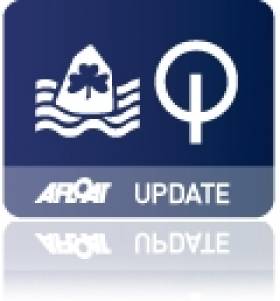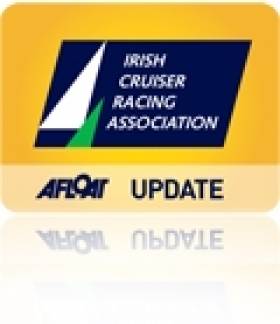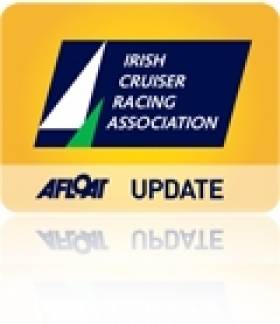Displaying items by tag: Royal Irish Yacht Club
SB20 2015 Fixtures Focus On Local Dublin Bay Scene
#sb20 – The Irish SB20 class has announced its 2015 programme that includes an expanded Dublin Bay racing programme with a 'user friendly' combination of ten Sunday races and four Saturday races all over preferred windward–leeward courses on the capital's waters.
Dun Laoghaire will host one SB20 regional event hosted by the Royal St George YC. The SB20 Nationals will sail from the nearby Royal Irish YC.
Download the full SB20 Irish fixtures programme for 2015 below.
Topping this off is the biennial Volvo Dun Laoghaire race week which means a whole summer's racing without ever leaving Dun Laoghaire.
National Yacht Club sailor James Gorman is the new Dun Laoghaire class captain who has overseen the new programme.
Howth YC is hosting the popular Spring Warmer sails and class president Justin Burke says this season starter 'dovetails nicely into the SB20 Easterns the following week'.
Royal Cork YC will host the SB20 Southerns and this will be the final warm up before the SB20 Worlds in Lake Garda where a large fleet is expected.
A new venue for the SB20 class will be in Northern Ireland at Whiterock on Strangford Lough Yacht Club in September.
The final event of 2015 will again be on the midland lakes in October.
2015 Sailing Calendar Includes Two Bicentenaries & Ireland's Biggest Regatta At Dun Laoghaire
Irishsailing – After the remarkable across-the-board success of the 2014 Irish sailing season, 2015 will have to be very special indeed to be remembered with such enthusiasm. But it's a special year in any case, as two major sailing Bicentenaries – one in the Irish Sea, the other in the Solent – will have added and poignant meaning, as the Centenaries a hundred years ago could not be celebrated because of the First World War.
As for Irish sailing generally, life moves on, there are new sailors on the water, successful young sailors are graduating to the next stage of their rapidly developing careers, and established stars continue to plan fresh campaigns, for sailing is indeed a sport for life.
Then too, new fixtures successfully introduced in 2014 will require nurturing, tuning and encouragement if they are to fulfil their potential in the coming year, while at the same time there's always extra effort needed to give proper support to established fixtures, which have to live with the reality that they might wilt through being taken for granted. Both new and longer-established boat classes will need continued enthusiastic involvement, and our well-loved classics and traditional craft must be cherished and sailed, for lack of use is the real enemy of boats, whether old or new.
As for the major administrative initiatives introduced in 2014, they will need constant monitoring, but deserve full support from the sailing and boating community at large, for it was in response to a grass-roots initiative that the radical and very necessary reforms of the Irish Sailing Association were undertaken. Those appointed to undertake the root-and-branch reform of the national authority have done so with commendable dispatch, so it is now the duty of the rest of us to support their continuing efforts. And we can best do that by enjoying our boats and our sailing and time afloat in its myriad of interests, while encouraging others to do the same. W M Nixon outlines on what the coming year may bring.
One thing at least is certain for the coming season afloat during 2015 in most of Europe. It will not mark any significant sailing Centenaries. Instead, we are immersed in four years of remembering the Great War of 1914-1918 a hundred years on, with all the added twists of that period's longer historical narrative in Ireland. In such a context, it may seem frivolous to point out that sports like yachting have no great Centenaries to mark at all in 2015. But this minor off-screen fact is a reminder of the all-involving horror and obscenity of total warfare on an industrial scale. It obliterated anything like normal life.
Yet as recreational sailing had been going on in some sort of organised form for hundreds of years – albeit in a fairly rudimentary way in its earliest years in the 16th Century – there may well have been several important dates to be marked during the time of the Great War itself, but they were allowed to pass as there was no sport afloat, while civilian life ashore was very subdued.
And in Ireland, with the Troubles persisting for four years after the end of the Great War until 1922, the Bicentenary of the Royal Cork Yacht Club in 1920 was to be a muted affair – the official History of the Royal Cork Yacht Club (published 2005) tells us: "Plans for a special dinner to celebrate the club's bicentenary in 1920 had to be cancelled, probably because of the disturbed conditions in the country"
So the idea of celebrating the Centenary of the Royal Yacht Squadron in Cowes in 1915 at the height of the international war - other than in a rather solemn shorebound way - would have been unthinkable. But that in turn fuels the celebrations when the peacefulgood times roll again. Thus the Royal Cork Yacht Club, having been unable to celebrate its Bicentenary in 1920, went on to have a fabulous two-year Quarter Millennium celebration in 1969-70. And as the RYS couldn't have a proper party in 1915, there's no doubt that the up-coming Bicentenary in 2015 will be the nucleus of international sailing's megafest-of-the-year.
There are of course several clubs which pre-dated the Squadron when it was founded in 1815. And there are many whose members outshine the small membership of the RYS in the breadth and energy of their sailing. But for 2015, let's just acknowledge that the prestigious Squadron has been at the heart of sailing history for a very long time, while their clubhouse's location right on the Solent at Cowes is so central that when any great Solent-related events are under way, the Squadron is in the middle of the story.
Thus it was on the Squadron lawn that in July that the Irish team celebrated their epic Commodore's Cup victory at the end of July 2014. And it will be towards the Squadron and its Bicentenary that the fleet will be racing in 2015's west-east Transatlantic Race. And then it will be the firing of the cannons from the historic Squadron battery which will signal the start of the 46th Fastnet Race on 16th August 2015.
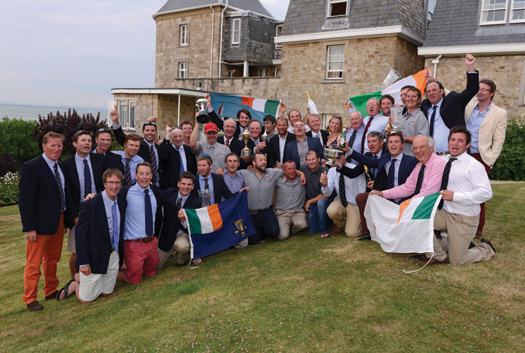
Party time at the Royal Yacht Squadron – the Irish team and their management gather to celebrate victory in the Commodore's Cup at the Squadron Castle in Cowes on August 1st 2014
There'll be many Irish boats involved, and the best-placed of them at the finish will be the winner of the Gull Salver, currently held by Martin Breen's Reflex 38 Lynx from Galway Bay SC, which was skippered to success by Aodhan FitzGerald in 2013's race. It's a coveted trophy, instituted to honour the memory of Harry Donegan of Cork and his famous cutter Gull, which was one of seven boats which inaugurated the Fastnet Race in 1925, and placed third. Since then, Irish Fastneteers have frequently been in the great race's top places, and best of all was in 2007 when Ger O'Rourke's Cookson 50 Chieftain out of Kilrush, sailing under the burgee of the revived Royal Western of Ireland YC, came sweeping in to the finish line at Plymouth to win the Fastnet Race
overall.
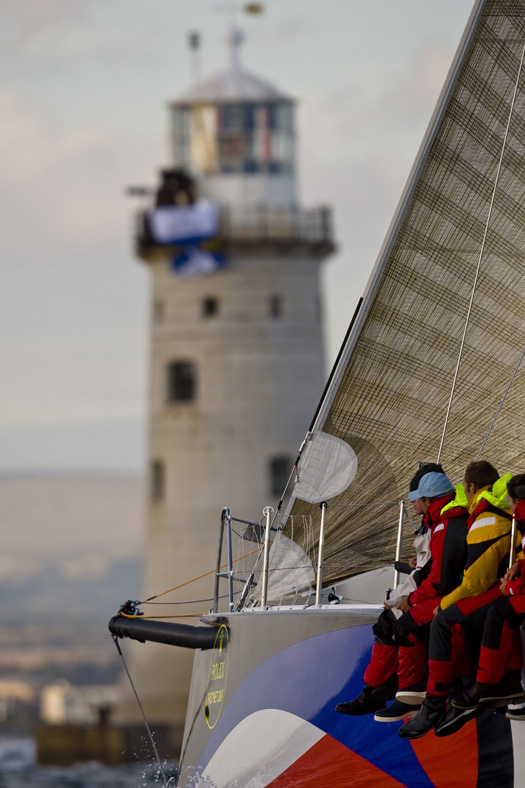
One of the greatest moments in Irish sailing history – Ger O'Rourke's Chieftain sweeps towards the finish line to become the overall winner of the Rolex Fastnet Race 2007. Photo: Rolex
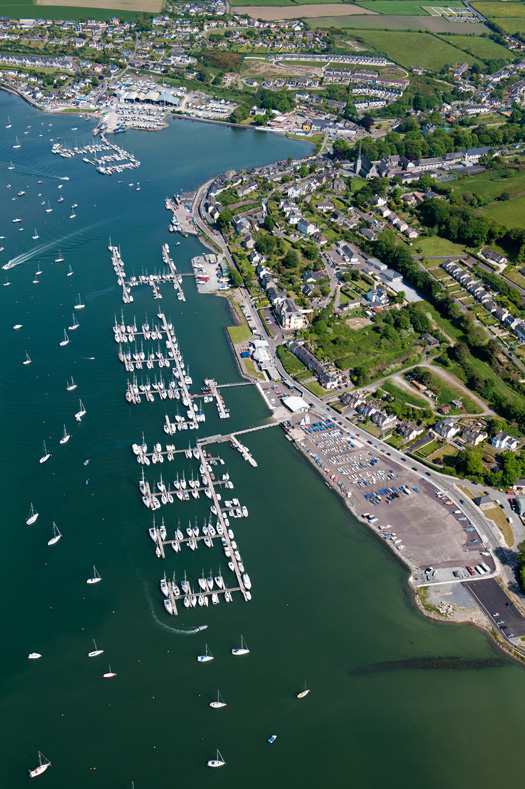
Just the spot for a great Tricentenary celebration - the very complete sailing facilities provided jointly by the Royal Cork Yacht Club and Crosshaven will become a world focus in 2020 with the Club's 300th anniversary. Photo: Bob Bateman
The realisation that 2015 sees this significant RYS Bicentenary is a timely reminder that the Royal Cork's Tricentenary is only five years down the line. They're five years which will be gone in a flash, and already behind-the-scenes moves are afoot to ensure that the national sailing programme will properly facilitate the extraordinary anniversary being celebrated in Crosshaven in 2020.
But meanwhile other Irish sailing centres have their own regular programmes to operate in the intervening four years, and in terms of numbers and scale there's no doubt the top event in Ireland in 2015 will be the biennial Volvo Dun Laoghaire Regatta from 9th to 12th July.
Anyone – and there were many - who took part in this unique "suburban sailfest" in 2013 will know that the VDLR has come of age. It's an event which is comfortable with itself while at the same time being always in development and evolution mode. Each staging of this remarkable Dublin Bay happening sees lessons being learnt and implemented even while the multi-class racing is under way on several courses. And in the two year gap before the next staging, the experience gained is closely analysed and the programme refined to further improve the sport in every area.
You get some idea of the sheer depth of racing experience in Dun Laoghaire by noting that the Chairman of the 2015 Committee is Tim Goodbody, with Martin Byrne as Vice Chairman while the Race Director is Con Murphy. And those three sailing megastars are just the peak of a mountain of race administration experience which is being drawn in from all over Ireland to ensure that the fleet of 400-plus boats gets the best sport possible.
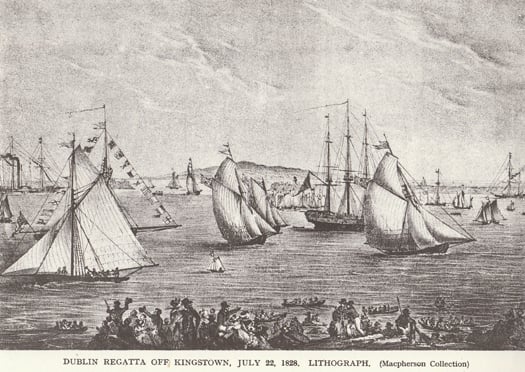
The first regatta in 1828 at the new harbour at Dun Laoghaire, which will be the setting for Ireland's biggest event in 2015, the Volvo Dun Laoghaire Regatta from 9th to 12th July.
While there'll be keenly participating boats from all over Ireland as well as Scotland, England and Wales, the setup of Dublin Bay being right on the city's doorstep means that it's the locals who would pose an administrative problem for a less experienced team. As the dates for the VDLR approached in 2013, the weather forecast steadily improved, and thanks to the Regatta's "extra long weekend" format, the sudden arrival of summer meant that a host of boats from the greater Dublin area came in as last minute entries, their owners and crews managing to scrape the extra day-and-a-half needed off work. It's a scenario which would put an overstretched administration off course, but the VDLR team took it calmly in their stride, and the result was a successful summer festival of sunlit sails and great sport, with maybe two thousand taking part.
This year there's a more structured cross-channel involvement, as the venerable Royal Dee YC in Cheshire has leapt to life to celebrate its Bicentenary. Founded as the Dee Yacht Club in 1815 with the end of the Napoleonic Wars, it didn't get the Royal seal until 1947, but nevertheless claims to be older than the RYS. With growing fleets in North Wales and the Mersey, it has put together a Bicentennial Royal Dee Irish Sea Offshore Championship linked closely to ISORA, which will bring the fleet across to Ireland to take in four offshore day races sailed as part of VDLR 2015.
Irish National Championships which will be part of the VDLR 2015 programme include the J/109s, the RS Elites, the Beneteau First 21s, and the Wayfarers, while the Leinster GP 14 Championship is also included as an integral part of the Regatta.
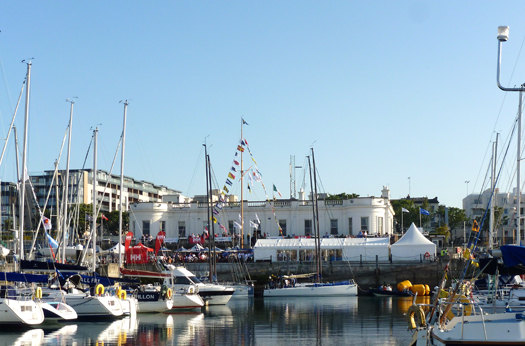
Party time in Dun Laoghaire – the Royal Irish YC during VDLR 2013. Photo: W M Nixon
As for Ireland's classic clinker-built vintage classes, one of the pleasantest surprises in VDLR 2013 was the large turnout of Mermaids, which had superb racing on the course area in the northwest corner of Dublin Bay. Despite having been born as the Dublin Bay SC Mermaid in 1932, this class of 17ft super-dinghies is no longer included in the regular DBSC programme owing to shortage of numbers for weekly turnouts. But it seems that as far as the VDLR is concerned, the Mermaid is now an event boat, and the fleets still thriving at other centres, together with some of the dormant Dublin Bay craft, bestirred themselves for the four days to enjoy good sailing for more than three dozen boats, something which is highly likely to be repeated in 2015.
The even more venerable Water Wags, founded 1887 with the current boats dating from 1903, continue to thrive in Dun Laoghaire, and the word is they expect to have at least twenty boats in action, while another wooden classic, the Mylne-designed 25ft Glen keelboat, is 50 years and more in Dun Laoghaire, and looks forward to having at least twelve boats racing in 2015.
All these specialized and historic classes are in addition to the numerous cruiser-racers which continue to be the backbone of Dublin Bay sailing. And while many of them will see the VDLR 2015 as a highlight of the year, in turning to consider the overall national programme, we find a sport which is shaking off economic recession to get on with an extraordinary plethora of local, national and international sailing events.
The problem is that most events of significance hope to locate themselves in the peak sailing period from late May to early September, so clashes are almost inevitable, and if you're interested in several different kinds of sailing, the overall choices can be bewildering in their complexity and logistical challenges.
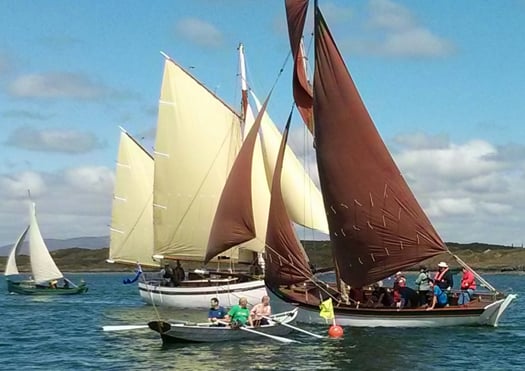
The Baltimore Wooden Boat Festival attracts an eclectic fleet – included here are a Shannon Gandelow, a West Cork Mackerel Yawl, the ketch Sile a Do, and an Heir Island Lobster Yawl (left).
For instance, the variety of events now available for the traditional and classic boats – usually but not necessarily under the Old Gaffer umbrella – would keep anyone busy for most of the summer. It starts with the Baltimore Wooden Boat & Seafood Festival from Friday 22nd May to Sunday 24th May, which you'd think very early
in the season for someone faced with fitting out an old wooden boat in Ireland's climate, but somehow they do it.
Then on the East Coast for the early summer Bank Holiday Weekend from May 29th to June 2nd, there's the Old Gaffer gathering in Dublin Bay at Poolbeg Y&BC with the annual race for the Leinster Trophy in the bay on Saturday May 30th, the event then morphs into the Dublin Port Riverfest in the Liffey on Sunday May 31st, and finally it all concludes with the race for the Asgard Trophy back in the bay on Monday June 1st.
The annual Lambay Race at Howth, a regular fixture since 1904, has seen its course becoming increasingly complex in modern times in order to satisfy the desire of modern racers for competition on every possible point of sailing. But in 2014, to celebrate the Centenary of the Lynch family's Echo, the venerable Howth Seventeens were sent on the traditional course north from Howth Harbour through the sound inside Ireland's Eye, then on round Lambay leaving it to port, and then back south inside Ireland's Eye again to the finish at Howth pierheads.
This was such an attractive proposition for Old Gaffers and Seventeens alike that on the day an extra Classics Division was added to cater for ancient craft, and it hit the spot. This option will be offered again for 2015's Lambay Race (it's on Saturday June 6th), and the word is that Dickie Gomes's 1912-built 36ft yawl Ainmara will be coming down from Strangford Lough to defend her title after 94 years. 94 years? Yes indeed - she won the Lambay Race in spectacular style in 1921 when still under the ownership of her designer-builder John B Kearney.
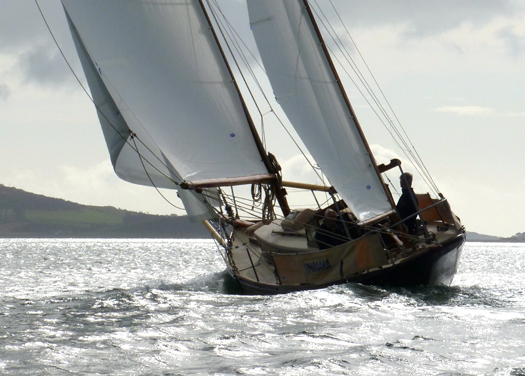
After 94 years, Dickie Gomes's 36ft 1912-built yawl Ainmara (seen here on her home waters of Strangford Lough) hopes to return to defend the title in Howth's Lambay Race, which Ainmara won in 1921 while still in the ownership of her designer-builder John B Kearney. Photo: W M Nixon
The Old Gaffers attention then swings north as the Tall Ships are coming to Belfast from Thursday 2nd July to Sunday 5th July. This is going to be a serious biggie with those ships already signed up including a significant turnout of Class A vessels, which are square riggers and others of more than 40 metres in length. Belfast Lough lends itself particularly well to the Parade of Sail which follows a Tall Ships gathering, and in 2009 when they were last in the port they put in in a virtuoso display with the Dutch ship Europa in particular going to the trouble of getting herself over towards Whiteabbey in the northwest corner of the lough to allow her time get every stitch of sail set before proceeding seawards down-lough in colossal style, a much more impressive display than we've become accustomed to in Dublin, where the shape of Dublin Bay is such that it doesn't really provide the space for square riggers to set all cloth before getting out to sea.
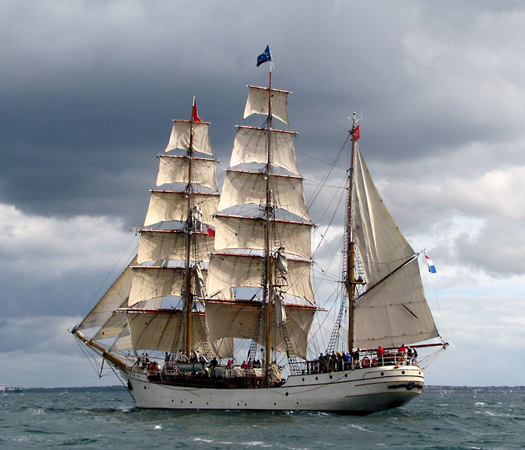
The Tall Ship Europa shows how it should be done in Belfast Lough in 2009, taking time out to set full sail before she starts to gather power to make the proper input into the Parade of Sail.
Like Dublin, Belfast has shown it can be hospitable to Old Gaffers, and it was a very welcoming main port during the OGA Golden Jubilee Cruise-in-Company in 2013, so for 2015 the OGA National President Sean Walsh hopes to up the ante by persuading his members from all round the Irish Sea to gather in Belfast, and to add spice to the mix, he hopes to persuade the Howth 17s to put in an appearance as well, to sail with local one designs like the 1903 Belfast Lough Waverley Class, which have been experiencing a revival in recent years.

Old Gaffers in Belfast for their Golden Jubilee in 2013. The Irish Sea classic and traditional fleet will return to the same venue for the Tall Ships gathering in July 2015. Photo: W M Nixon
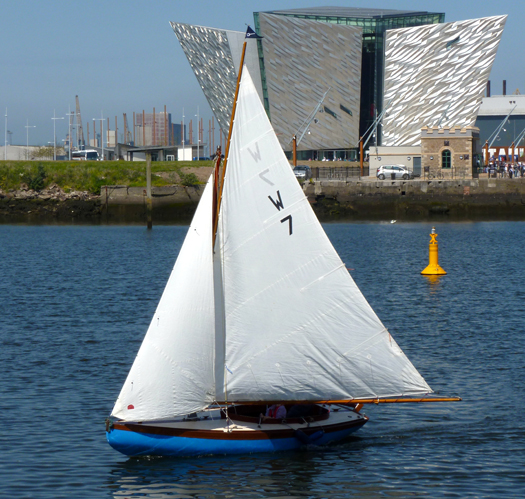
The Belfast Lough Waverley Class Lilias (built 1903) sailing at the Titanic Centre in Belfast. In 2015, the Waverleys will be joined by some of the 117-year-old Howth 17s to participate in the visit of the Tall Ships. Photo: W M Nixon
The Seventeens have made long treks as a class before – in 1998, five of them were road-trailed to Carrickfergus to mark the class's Centenary, with the first five boats built by Hilditch of Carrickfergus. So though they'd trailed there, they then sailed the 90 miles back to Howth, just as the first boats had done a hundred years earlier. Then in July 2003, fifteen of the Seventeens took part in the Glandore Classics Regatta thanks to a brilliantly organised exercise in logistics using a flotilla of low loaders which could take three boats apiece.
For all of Ireland's classic and traditional boats in 2015, and an international fleet too, Glandore is very much up on the radar again, as a special effort is being made by a GHYC team led by Donal Lynch to encourage increased numbers in the CH Marine Glandore Classic Regatta from Saturday July 18th through Friday July 24th. It's a date which certainly allows Old Gaffers plenty of time to get down from Belfast, indeed some may even consider the option of making the voyage northabout to take in a round Ireland cruise while they're at it. And as that great magnet of the Irish Sea classic and traditional scene, the Peel Traditional Boat Weekend, isn't until Friday 31st July to Sunday 2nd August, it's just about possible to factor that in as well.
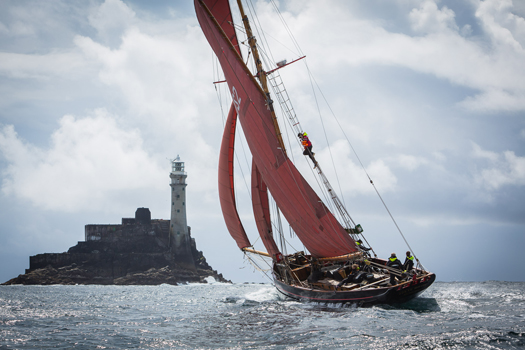
Everything happening at once – the famous Pilot Cutter Jolie Brise was the star of the Glandore Classics in 2013, and as it was her own Centenary she celebrated by sailing round the Fastnet Rock – she has been a successful Fastnet Race participant several times. Photo: Brian Carlin
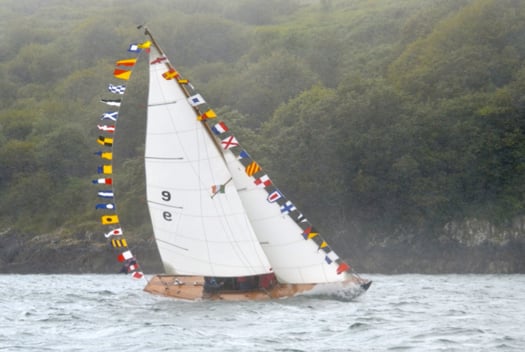
The Glandore Classics attracts an international fleet, and 2013's regatta included a class of Fife One Designs from the Menai Straits, all of them keen to party and showing it. 2015's Glandore Classics is from July 18th to 24th. Photo: Cormac O'Carroll
All this is already happening for the oldies with August barely under way, yet for modern cruiser-racers the potential programme for any keenly-sailed Irish boat is equally complex, attractive and challenging. The season starts as usual with the Scottish Series from Friday 23rd May to Monday 26th May – there'll probably still be snow on the mountains of Arran. They've gone back to their roots by starting with a feeder race from Gourock to the main regatta centre at Tarbert on Loch Fyne. "Going back to the roots" is something of a theme for this year's staging of the Clyde Cruising Club's main racing event, as this is the 40th Scottish Series. Come to think of it, there are so many important 40th anniversaries happening in sailing these days that we have the admit that the decade which brought us the full horror of wide lapels and flared trousers also contributed some lasting elements of the international sailing scene, indeed it could be said that the modern era in sailing really began about forty years ago.
Back in Ireland, the ISORA programme will be well under way by June, while the Lambay Race on June 6th can be looked at with more interest by several boats, as the biennial National YC Dun Laoghaire to Dingle Race doesn't start until Friday June 12th . Last time round, there was a total fixtures clash between the two events, but in times before that hyper-keen sailors such as the Tyrrells of Arklow with Aquelina have been able to fit in both, indeed one year they did it so well they won both too, and were rightly acclaimed as the Afloat "Sailors of the Month" for their success.
For 2015, defending champion in the Dingle Race is Brian O'Sullivan of Tralee with the veteran Oyster 37 Amazing Grace, which came good in the end in 2013 with a new breeze which knocked pending leader Antix (Anthony O'Leary) off the winning perch. But with the 2015 Dingle Race acting as a useful if rather indirect feeder for the Covestone Asset Management Sovereigns Cup in Kinsale from June 24th to 28th, there could be all sorts of sharp boats lining up to take the prize, for the Sovereigns Cup 2015 includes the all-singing all-dancing ICRA Nats 2015.

The welcoming port – Kinsale is one of Ireland's most popular destinations, and in 2015 its hosts the combined Sovereigns /ICRA Nationals from June 24th to 28th.

Perfect sailing – racing in the Sovereigns at Kinsale in June 2013. Photo: Bob Bateman
Yet the timing of the combined Sovereigns/ICRA Nats is such that there's still plenty of time and space to get back to the Irish Sea for the Volvo Dun Laoghaire Regatta 2015 from July 9th to 12th, a reminder that much of the cruiser-racer programme for 2015 is in a neatly balanced and user-friendly timescale for everyone except perhaps those who wish to do either the entire ISORA or SCORA programme as well, so the problem mostly is going to be getting time off work.
And for the hyper-keen cruiser-racers, particularly those whose boats are small enough to be conveniently trailerable, further temptation looms in 2015 with the WIORA Championship at Galway Bay Sailing Club from July 22nd to 25th. For the fleets in the Shannon, on Tralee Bay, and in Clew Bay, it's a bit more than a day's sail away, but they'll be there to challenge Liam Byrne of the home club who won it in 2014 with his Corby 25 Tribal at Mayo SC in Clew Bay, while some top boats from more distant centres are expecting to trail to Galway Bay to spice up the competition.
By this stage of the season a more relaxed pace might be welcome, but the lively turnout of 80 boats in 2014 for the new-style four day Cork Dry Gin Calves Week out of Schull in early August (Tuesday 4th to Friday 7th August in 2015) suggests that for racing sailors, the best relaxation is more racing, but in a holiday setting. And yes, it has been noted that a true West Corkian sailing nut could indeed do all of Calves Week 2015, and still be on the Squadron line for the start of the Fasnet Race nine days later.
For dinghies in 2015, the big story is the debut of the newest version of the National 18, and just how popular will the Bray-bult foiling Moths become, while established classes will frame their programmes to accommodate sailors whose time is limited, also having to fit in with a national scene where the number of Race Officers with the necessary skills is inevitably a finite amount.
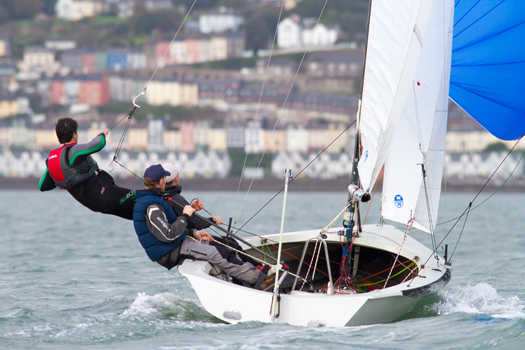
The big stories in Irish dinghy racing in 2015 will be the arrival of the new National 18s at Crosshaven, and the revival of Dinghy Week there in late August. Here, in the Autumn of 2013, To Dwyer and Nin O'Leary test sail the prototype of the new 18 on Cork Harbour. Photo: Bob Bateman
The new Third Generation (or maybe it's fourth or fifth generation) National 18 may have been designed in England by Phil Morrison, and is being built there too. But it was the very active Crosshaven fleet with the Royal Cork Yacht Club which led the charge towards a new boat, and when it came to stepping up to the plate to pay twelve substantial new boat deposits to move it all along after the prototype had been rigorously tested in Cork harbour last Autumn, it was the Crosshaven fleet that provided eight out of those twelve cheques.
So it's entirely appropriate that in August 2015, the dinghy focus will swing big time towards Crosshaven and a short form "Dinghy Week" from August 21st to 23rd. The old style Irish Dinghy Weeks – the last one was in 1970 – became victims of their own success, they just got too large. But the different classes became over-optimistic about their continuing individual growth prospects. Then the pendulum swung too far the other way, and dinghy classes were alone and their events shrinking. But a resurgence of club and championship dinghy sailing in Crosshaven during 2014, and a growing realization that over-reliance on single-handed dinghy classes does not necessarily produce a socially-adjusted national squad of junior sailors, resulted in some clear and creative thinking about developing two-handed boats, and reviving some old classes such as the Mirrors.
The form of this new Dinghy Week is still in the melting pot, but at least eight classes have responded with enthusiasm. Meanwhile, the National 18s in Crosshaven will be such a focus of interest during 2015 with the first of the new boats making their debut that we'll have a season-long dinghy narrative developing on Cork Harbour, and the revived Dinghy Week will be just part of it.
As for inshore keelboats, the big one in terms of number is the combined British and Irish Championship Squib Championship at Howth from 27th June to 3rd July. The handy little Squibs are something of an oddity, as they serve so well as a cherished local class in so many Irish sailing centres that many owners see them as that, and nothing more – handy little club sailors to be raced on home waters a couple of times a week.
This means that when a major regional or national event is held, the number taking part will often only be a fraction of the total Irish Squib fleet. But for those who do make the trek, the competition is fierce and the racing great – in Howth, the high point was in 1996, when this "Nationals" event attracted a fleet of exactly a hundred boats, and on one never-to-be-forgotten morning, there they were, every last one of them on the starting line.

A hundred Squibs all in a row at Howth on Tuesday July 25th 1996. Photo: Mandy Murnane
The most recent Squib event of national stature was the Freshwater Keelboat Regatta at Dromineer on Lough Derg on the weekend of October 18th-19th, and the battle for the top places was between the Kinsale and Belfast Lough fleets, with James Matthews and Rob Jacob of Kinsale rounding out their year in style with a good win.
But with the Squibs in England undergoing a revival – they were the second-biggest One Design fleet in Cowes Week 2014, bested only by the legendary XODs – there's no doubt there's a strong challenge coming across channel, and any Irish boat getting into the top ten will be doing well.
As for that annual Autumn Freshwater Keelboat Regatta at Dromineer, while it may have been much hampered by the spinoff from some ferocious weather out in the Atlantic with frustration for some of the sixty boats hoping to take part, it's an event of enormous potential, and the many who wish it well and have enjoyed it in the past will be ready and willing to do their part to make 2015's regatta a success.

The Squibs enjoying a lull in the strong winds during the Lough Derg Freshwater Regatta 2014. Overall winner was Mucky Duck (no 51, James Matthews & Rob Jacob, Kinsale YC). Photo: Gareth Craig
All these specialised and localized events planned for 2015 will be the continuing background music to the usual events of national sailing focus, everything from the selection of the Irish team for the Student Yachting Worlds to the Helmsmans Championships to the steady increase in pace while 2015 develops as the pre-Olympic year. As the year rolls along, other stories will develop too. So perhaps it's appropriate that we exit this review as we entered it. Just pause to remember now and again that, a hundred years ago, you simply couldn't have gone freely afloat like this for sport and recreation at all.
But we can't close on such a solemn note. Seasoned Solent sailors may have noted our header photo from Guido Cantini at the Panerai Classics Regatta was looking just slightly odd, for some reason difficult to pin down. Well, as it happens, the photo was sent to us back in September just as we were contemplating the excellent cleanup up done by Jason Hurley of Jason Hurley Design on the Mercedes-sponsored billboard photo of Howth 17s on the end wall of Howth Yacht Club. As with many photos taken over the RYS starting cannons, the Cantini pic included an obtrusive part of the Fawley Oil Refinery across on what Isle of Wight people call "the north island". Though Fawley has been there for yonks, it still has the look of a temporary structure. So we got Jason to treat as just that. But here for your edification is the true picture. You could get a taste for this sort of thing. What about brushing out Whitegate, lads? And as for Milford Haven.........
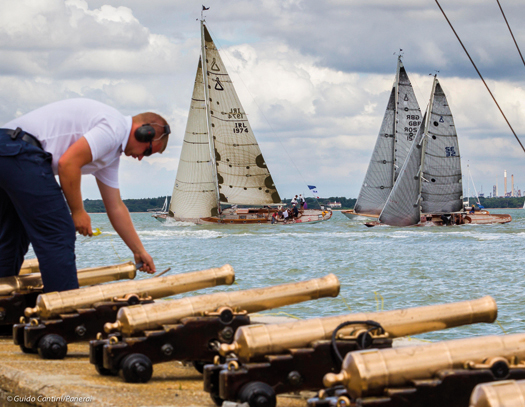
The unvarnished truth. In real life, the view from the RYS battery at Cowes can be slightly marred by the clutter of Fawley Refinery across the Solent on "the north island". Photo: Guido Cantini/Panerai
Read also: 2015 Irish Sailing Fixtures List (provisional)
Round Ireland Yacht Race – Where Next? What Next?
#roundireland – The biennial Round Ireland Race from Wicklow is the jewel in Ireland's offshore racing crown. It may only have been established as recently as 1980, but now it is a classic, part of the RORC programme, and an event which is very special for those who take part. In fact, for many Irish sailing folk, having at least one completed Round Ireland Race in your sailing CV is regarded as an essential experience for a well-rounded sailing life. Yet despite fleets pushing towards the 60 mark in the 1990s, even before the economic recession had started tobite the Round Ireland numbers were tailing off notwithstanding the injection of RORC support, and the more recent bonus of it carrying the same points weighting as the Fastnet Race itself. At a time when the basic Fastnet Race entry list of 350 boats is filled within six hours of entries opening for confirmation, and when the Middle Sea Race from Malta has confidently soared through the 120 mark, while the 70th Sydney-Hobart Race in seven weeks time will see at least a hundred entries, the Round Ireland Race fleet for 2014 was only 36 boats, of whom just 33 finished. W M NIXON wonders how, if at all, this situation can be improved.
"The Round Ireland Race is the greatest. Why don't more people know about it? Why aren't there at least a hundred top boats turning up every time it starts? It's a marvellous course. We had great sailing and great sport. Can somebody tell me why a genuine international offshore racing classic like this has been going on for 34 years, and yet in 2014 we see an entry of only three dozen boats?"
The speaker isn't just any ten-cents-for-my-opinion waterfront pundit. On the contrary, it's Scotsman Richard Harris, skipper and part-owner with his brother of the potent 1996 Sydney 36 Tanit, the overall winner of the Round Ireland Race 2014. And he's asking these questions as someone who has raced with success in both the Fastnet and Sydney-Hobart Races, and has campaigned his boat at the sharp end of the fleet with the RORC programme from the Solent, and in any worthwhile offshore racing he has managed to find in his home waters of Scotland.
Harris is getting into fine form, as we're at the Tanit table for Wicklow Sailing's Club's Round Ireland Prize-giving Dinner-Dance in the Grand Hotel in Wicklow town last Saturday night. With a boxload of trophies for Tanit to collect, anyone would be in exuberant spirits. But his views on the quality of the Round Ireland Race are clearly thought out and genuinely held, and he is enthusiastically supported by his navigator, Richie Fearon.
Fearon is the man to whom the Tanit crew give the lion's share of the credit for their success, which was achieved by just six minutes from Liam Shanahan's J/109 Ruth from the National YC in Dun Laoghaire. He was the only one in Tanit's crew who had done the race before, and in an all-Clyde lineup, his was the only Irish voice, as he sails from Lough Swilly YC in Donegal. His previous race was in 2010 with the Northern Ireland-based J/124 Bejaysus (Alan Hannon), which finished 7th overall. But for the Derry man, second time round made the course if anything even more interesting.
"You get a wonderful sense of the race progressing all the time, of moving along the course" says Fearon. "In the Fastnet, for instance, there are periods when you feel as though you're sailing in a sort of limbo. But in the Round Ireland, you're always shaping your course with the next rock or island or headland or wind change or tidal time in mind. There's a fascinating and challenging mix of strategy and tactics and navigation and pilotage, all of which results in one of the most interesting distance races in the world. They really should get more people to do it. It gives a wonderful feeling of achievement and completeness when you just finish the course. And it's even better if you do well, as we felt we'd done in 2010. But believe me, winning overall, and in a boat as interesting as this with a crew of guys as good and as friendly as this, that's the best of all!"
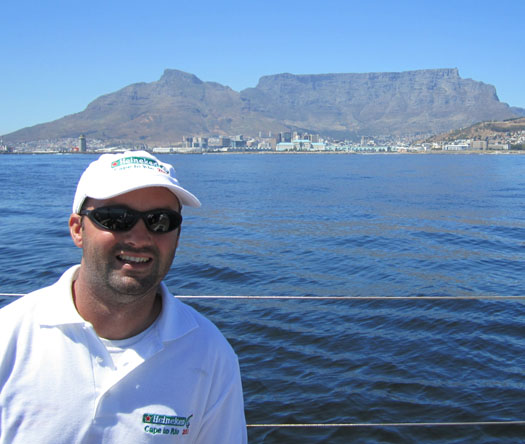
Richie Fearon of Lough Swilly YC, seen here kitted up off Cape Town for the Transatlantic race to Rio, navigated Tanit to the overall victory in the Round Ireland 2014
So how do you explain to such people, people who have become Round Ireland enthusiasts with all the zeal of recent converts, just why it is that Ireland's premier offshore event can barely attract a viable quorum when the yacht harbours of Europe are bursting with high-powered offshore racing boats which are constantly on the lookout for events worthy of their attention, not to mention commercial offshore racing schools and training programmes which need events like the Round Ireland Race to stay modestly in business?
How indeed, when we already have enough difficulty in explaining it all to ourselves. Inevitably, we have to look at the history, and the setting of that history. The last time I was at the Round Ireland Prize-Giving Dinner-Dance in Wicklow, there'd been enough participants from my home port of Howth in that year's race to make it worthwhile for us to hire a bus to go down through the Garden County for the party. We were in the midst of the Celtic Tiger years when people's expectations were becoming very pretentious, and I remember two foodies seated nearby in the bus pompously hoping to high heaven that the evening's meal wouldn't be the inevitable rural feast of beef or salmon.
But the charm of Wicklow town is that, though it's barely a forty minute drive from the capital, it is very much of the country - l'Irlande profonde as you might say. 'Tis far you are from big city notions of fancy menus to appeal to jaded metropolitan taste-buds. So it was indeed beef or salmon. Not that it really mattered that much to the crowd on the bus from Howth. They were well fuelled with on-board liquor by the time we got there, and the return journey in the small hours was made even longer by the need for frequent comfort stops, thus all they'd needed in the meal was absorbent food to mop up the booze.
Some things have changed greatly in the past few years, not least that there was so little Howth involvement in 2014's race that one very modest car would have done to get all the participants to last Saturday night's prize-giving dinner dance in Wicklow. But some things, thank goodness, don't change. It was still beef or salmon. And very good it was too, as salmon is excellent fish if you don't try to pretend that it's steak and grill it. That brings out its least attractive taste elements. But a baked darne of salmon with a well-judged sauce, such as we had last Saturday night, is a feast for a king. And I gathered the roast beef was very good too.
But it all reinforced the feeling that we were in the biggest hotel – the only hotel? - in a small Irish country town. Yet apart from the sailors at the night's event, there was nothing to suggest that Wicklow is a port, for there's something about the layout of the place which makes the harbour waterfront wellnigh invisible unless you seek it out. It's a delightful surprise when you do find it, but it's very much a little working port, rather than a natural focus for recreational boating and the biennial staging of one of the majorevents in the Irish sailing calendar.

You almost have to take to the air to see that Wicklow is a little port town, for as this photo reveals, the main street turns its back very decisively on the workaday harbour in the Vartry River.
It was back in 1980 that Michael Jones of Wicklow Sailing Club took up boating magazine publisher Norman Barry's challenge for some Irish boat or sailing club, any maritime-minded club at all, to stage a round Ireland race. Jones went for the idea, and Wicklow have been running it every other year ever since. It may be the jewel in Irish offshore sailing's crown. But in Wicklow's little sailing club, it is the entire crown, and just about everything else in the club's jewel and regalia box as well.
Whether or not this is good for the general development of sailing in Wicklow is a moot point, but that's neither here nor there for the moment. What matters is that as far as the growth and development of the Round Ireland Race is concerned, in the early days of the 1980s the fact that Wicklow was a basic little commercial and fishing port with only the most rudimentary berthing facilities for recreational boating didn't really matter all that much, as most other harbours in Ireland were no better.
In 1982, the great Denis Doyle of Cork decided to give the race his full support with his almost-new Frers 51 Moonduster. Denis was someone who strongly supported local rights and legitimate claims, and he reckoned that the fact that Wicklow Sailing Club had filled the Round Ireland Race void, when larger longer-established clubs of national standing had failed to step up to the plate, was something which should be properly respected. So in his many subsequent participations in the Round Ireland Race, Moonduster would arrive into Wicklow several days in advance of the start, she would be given an inner harbour quayside berth of honour in a place as tidy as it could be made in a port which seems to specialise in messy cargoes, and Denis and his wife Mary would take up residence in a nearby B & B and become Honorary Citizens of the town until each race was started and well on its way.
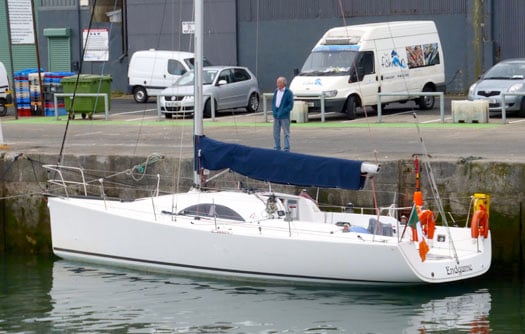
Like father, like son. Denis Doyle's son Frank's A35 Endgame from Crosshaven berthed in Wicklow waiting for the start of the Round Ireland Race 2014, in which she placed fourth overall and was a member of the winning team for the Kinsale YC Trophy. Photo: W M Nixon
It was an attitude which they brought to every venue where Moonduster was raced. The Doyles believed passionately that boosting the local economy should be something that ought to be a priority in any major sailing happening, wherever it might be staged. Denis had been doing the biennial Fastnet regularly for many years before he took up the Round Ireland race as well, and for a longtime beforehand he and Mary had also had the Honorary Citizen status in Cowes, as he would make a job of doing Cowes Week beforehand, living in digs in the town, while at race's end in Plymouth, there'd be a local commitment as well, albeit on a smaller scale.
This was all very well for Wicklow and the Round Ireland in the circumstance of the 1980s, but by the 1990s other ports were developing marinas and providing convenient facilities, yet Wicklow stubbornly stayed its own friendly but inconvenient self. When we look at the geography of the harbour, we can see why, and see all sorts of things that might have been done differently a very long time go.
For instance, when the Vikings were first invading and intent on making Wicklow one of their key ports, it could have been developed in a much more useful way if only the native Irish had made them welcome. Can't you just see it? "We'll overlook the rape and pillage for now, lads, these guys represent substantial inward investment". Just so. Had there been that far-sighted attitude, the locals could have invited the men in the longships to come on up the River Vartry, and into the magnificent expanse of the Broad Lough. What a marvellous vision that would have revealed. With some minor rock removal and a little bit of dredging in the entrance, it could be a wonderful extensive natural harbour in a beautiful setting. Had that happened, just think how differently the facilities of modern Wicklow harbour might now be.
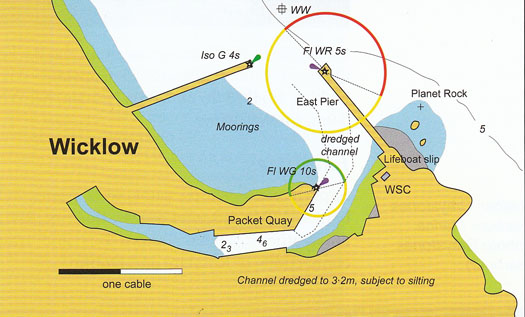
The navigable part of Wicklow Port as it is today. The water does not really come to a sudden straight-line stop as shown on the left – that's just the bridge. Plan courtesy Irish Cruising Club
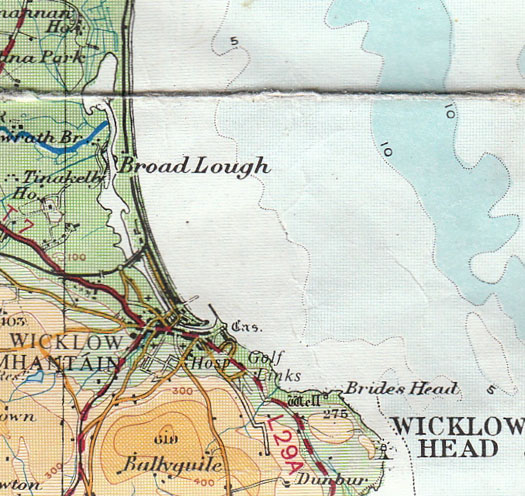
The bigger picture. Had the Vikings not been stopped such that they had to establish their settlement at the mouth of the Vartry River, they might have been able to create a much larger harbour settlement further in around the shores of the Broad Lough, with obvious advantages for Wicklow Port as it might have become today
Instead, the Vikings struggled ashore on the first available landing place at the first bend of the river, and established a beach-head which became such a successful little fort that eventually they were able to burn their boats. But by thattime, they were totally committed to having Wicklow town in its present cramped location. Access to the Broad Lough at high water (there's a very modest tidal range tidal) was soon restricted by the bridge, and then other river crossings, such that today nobody thinks of it as a potential harbour at all, if they ever did.
But meanwhile the current inner harbour is a cramped and dirty river which seems to be ignored by the town as much as possible, such that even the Bridge Tavern, the birthplace of Wicklow's most famous seafarer, Captain Robert Halpin of SS Great Eastern and trans-oceanic cable laying fame, turns its back firmly on the port. And as for the outer harbour, while it's a delightful place on a summer's day, it is not a serious proposition for berthing a large fleet of boats preparing for a major 704-mile offshore race, but people have to make do with it as best they can.
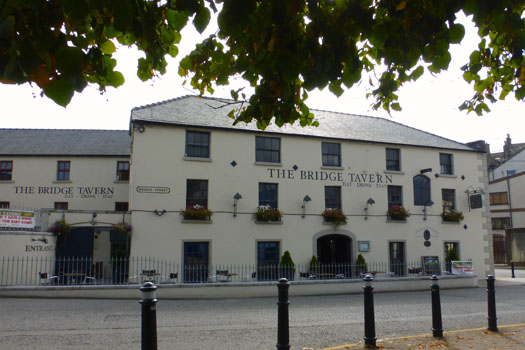
Despite being the birthplace of the most famous Wicklow seafarer, Captain Robert Halpin, the Bridge Tavern turns its back on the harbour. Photo: W M Nixon
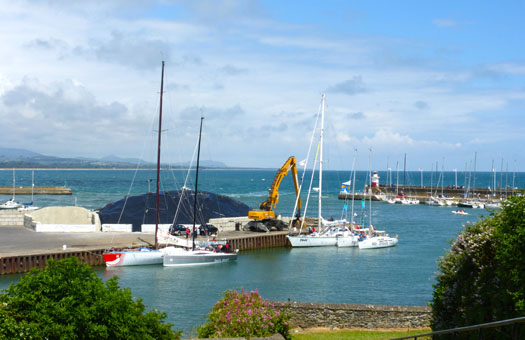
Wicklow's Outer Harbour on the morning of the Round Ireland race 2014 is a lovely sunny spot..............Photo: W M Nixon
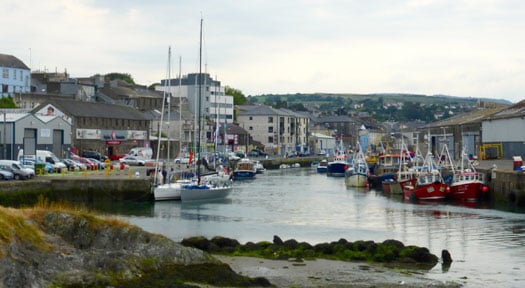
....but it is the inner harbour, shared with fishing and other commercial craft and assorted non-maritime quayside businesses, which will shelter the fleet preparing for the Round Ireland Race. Photo: W M Nixon
It was in the 1990s when the Round Ireland fleet was at its peak that the problems with the harbour's limited facilities were at their most acute, and it may be dormant memories of those difficult conditions which contribute to today's shortage of enthusiasm for the race. Back in the 1990s, the average cruiser-racer was not kitted out as a matter of course to RORC requirements, thus those undergoing their first scrutiny in order to be allowed to race round Ireland had to get to Wicklow several days in advance, and then often spendmoney like water to get up to scratch, the necessary bits and pieces being supplied by chandlers' vans parked on the quay.
It was crazy, not unlike a waterfront version of Ballinasloe Horse Fair - all that was missing was Madame Zara in her shiny caravan giving out nautical horoscopes in sepulchral tones for the wannabe Ireland circumnavigators. Perhaps she was there, but the two times I was going through the process with my own boat, it was so hectic I wouldn't have noticed. All I wanted to do was get to sea and away on the race, and get the filth of Wicklow harbour washed off the boat as soon as possible, as we'd drawn the short straw and had been berthed right in against the quay, so everyone has used our boat as a 35ft doormat on their way across to their own craft.
But the finish of the race at Wicklow – now that was and is completely different. The place seems to have transformed itself while you've been away bashing through sundry waters and a lot of the Atlantic in the intervening five days. Everyone is feeling like a million dollars, and Wicklow seems the only proper place in the whole wide world to finish a major offshore race. And as for the Round Ireland Prize Giving Dinner Dance, the venue of the Grand Hotel and beef or salmon for the meal is all part of the formula, it's central to the mystique of this extraordinary event.
In the days of the big entries with massive sponsorship from Cork Dry Gin, the prize-giving was Dublin-centred even if the race had started and finished in Wicklow. And the big bash in the city would start with a huge reception leading on into a gala dinner (I don't remember much dancing) in a glitzy Dublin hotel. In truth, it seemed a bit remote from little boats making their ways alone or in ones and twos back into Wicklow after the profoundly moving experience of racing right round our home island.
By the time you'd done all that, only others who have done the same could truly share your feelings about the experience. Big parties in anonymous city hotels were not the ideal setting for the Autumnal prize-giving and de-briefing. Thus the contemporary final hassle of getting down to Wicklow for the Round Ireland Dinner on a black November night in a veritable deluge of a downpour could be seen as the last stage of a long weeding-out process.
But once you're into the Grand Hotel and the party is under way, it's magic and the camaraderie really is quite something. Old rivalries and grievances fade away. It is also, to a remarkable extent, a family gathering – the number of family crews involved is surely exceptional. And the tone of it for 2014 is set by the presence of the winner of the KYC Trophy for the best three boat team, for the winners had as their top-placed boat the A35 Endgame, fourth overall and owner-skippered by Frank Doyle RCYC, son of Denis and Mary Doyle.
However, inevitably the status of the race and its future development and expansion is something which just won't go away. Any doubts about its importance were soon dispelled by considering the special guests at the dinner, as they included the President of the Irish Sailing Association David Lovegrove, the Vice Commodore of the Royal Ocean Racing Club Michael Boyd of the RIYC, and the Commodore of the Royal Irish Yacht Club, Jim Horan, whose club in 2014 was for the first time in association with Wicklow Sailing Club on the Round Ireland Race. The RIYC acted as hosting club in Dun Laoghaire for visiting boats which didn't want to go on down to Wicklow until shortly before the start, but wished toavail of modern marina facilities and the amenities of a large sailing port in the meantime.
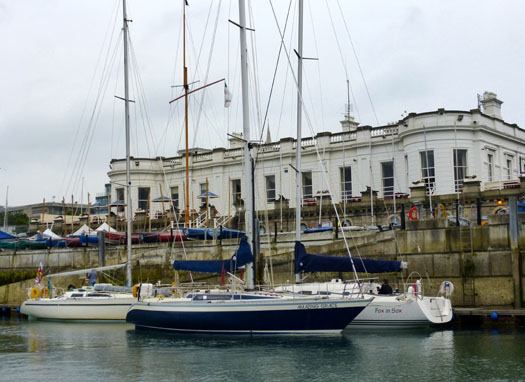
The switched-on crews going to Dun Laoghaire before the start of the Round Ireland Race 2014 knew that the best approach was to make themselves known at the Royal Irish YC and get a berth there, instead of allowing their boats to be banished to the "Siberia" of Dun Laoghaire Marina's remote visitors berths. Photo includes the MG38 McGregor IV from Essex which finished tenth overall (left), and the Oyster 37 Amazing Grace from Kerry, which had been in the frame but was forced to retire with equipment failure. Photo: W M Nixon
It was a partnership with potential, but it will need to be worked on. For although boats from other parts of Ireland knew that on arrival in Dun Laoghaire the secret of being well looked after was to make your number directly with the RIYC, boats from further afield coming into Dublin Bay tended to contact the marina, and thus they were stuck into Dun Laoghaire Marina's absurd visitors' berths, which are right at the very outer end of the pontoons, way out beyond acres of currently empty berths, such that it's said that anyone on them is one whole kilometre's walk from dry land.
Before the Round Ireland Race, the eventual winner Tanit was brought up from the Solent to Dun Laoghaire by a delivery crew who contacted the Marina Office, and she was stuck out in the Siberia of those Visitors Berths. It did mean that when she was first properly seen in Wicklow Harbour on the morning of the race, her impact as clearly an extremely attractive and very sound all round boat was all the greater. But nevertheless, if that is Dun Laoghaire Marina's idea of making visitors welcome, then they need to do something of a reality check, and it was a telling reminder that many Dun Laoghaire and Dublin Bay sailors are so absorbed in their own clearly defined and time-controlled activities afloatthat it leaves them with only limited attention for events outside their own sphere of interest.
As for Dun Laoghaire's general public, is there any interest at all? If the start of the Round Ireland Race was shifted to Dun Laoghaire, as some suggest, do you think the vast majority of the locals would take a blind bit of notice? At least in Wicklow they do make a bit of a fuss on the day of the start, with a community-sponsored fireworks display the night before.
In a final twist, in setting up the new Wicklow-Dun Laoghaire relationship, nobody had thought of the Greystones factor. Most had been unaware that the new Greystones marina is unexpectedly very deep. But such is the case, as I learned on Saturday night from the man from Newstalk. It's one of the reasons it cost the earth to build the little place. But it did mean that, in the buildup to the Round Ireland Race, while two of the deepest boats, the Volvo 70 Monster Project chartered by Wicklow's "Farmer" David Ryan, and the Farr 60 Newstalk, were unwilling to berth in Wicklow itself, they'd only to go a few miles north to find a handy berth in Greystones, where they were still very much in Wicklow county. There, they were the focus of much attention. For as we've discovered at Afloat.ie, if we lead a story #greystones, the level of interest is amazing.
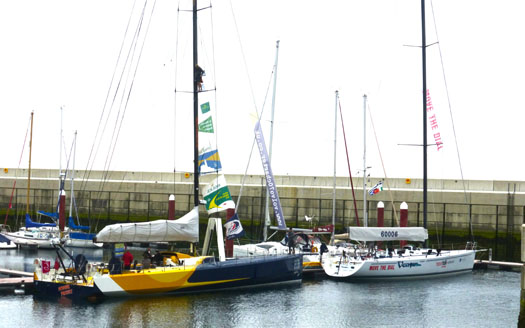
The exceptionally deep water in Greystones Marina provided trouble-free berthing for the Volvo 70 Monster Project and the Farr 60 Newstalk. Photo: W M Nixon
Perhaps after their attendance at the Round Ireland Dinner in Wicklow last Saturdaynight, Tanit's crew now have a better understanding of why the Round Ireland Race is in its present format. And I certainly understand why the level of close personal attention which goes into the race administration by the small team in Wicklow SC running it adds greatly to its appeal for dedicated participants. Before going to Wicklow, I'd been checking with the eternally obliging Sadie Phelan of the race team whether or not Richard Harris would be there, as I had to admit I thought his boat was only gorgeous. "Of course he'll be there" says Sadie, "and I'll put you at his table".
Not only that, but the winner Tanit's table and the runner-up Ruth's table were cheek by jowl, so much so that I was almost sitting at both of them. It would have taken a team of scribes to collate all the information flying back andforth, but everything was of interest.
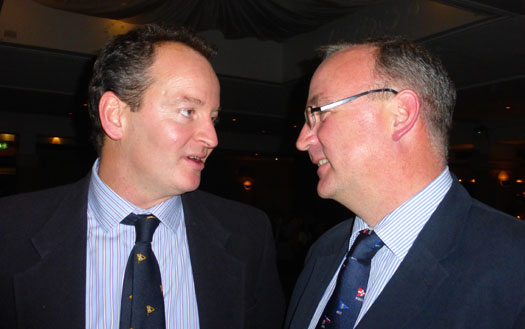
Just six minutes separated them at the end.....winner Richard Richard Harris of Tanit (left) and runner-up Liam Shanahan of Ruth at the Round Ireland prize-giving in Wicklow last Saturday night. Photo: W M Nixon
Richard (42) and his brother have owned Tanit for about twelve years, but as his brother is into gentler forms of sailing, the offshore campaigns are exclusively Richard's territory. In early sailing in the Clyde, they'd campaigned a Sweden 36 with their late father while Richard's own pet boat was a classic International OD. But as his interest in offshore racing grew, heidentified the Australian Murray Burns Dovell-designed Sydney 36 as ideal for their needs. He found there was only one in Europe, a 1996 one, little-used and in the Solent. They soon owned her, and changed her name to Tanit as the family firm is Clyde Leather, a vibrant firm which is the only suede tannery in Scotland.
Thus as raced in the Round Ireland, Tanit had the logo of Clyde Marine Leather on her topsides - a useful sideline is suede products for marine use, including a very nifty range of attractively-priced DIY kits for encasing your stainless-steel steering wheel in suede. Show me a boat which has a bare steel wheel, and I'll show you a boat which is on auto-pilot for an indecent amount of the time. But if you are doing the suede coat thing on your helm, be sure to cover the spokes as well, it makes all the difference for ultimate driver comfort.
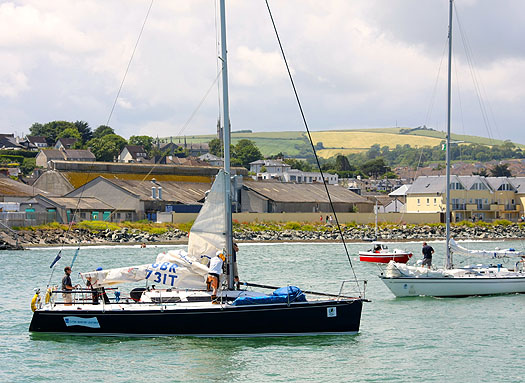
The boat from God knows where....Tanit (left) was an unknown quantity when she made her debut in Wicklow Harbour on the morning of the Round Ireland Race 2014, but father and son crew Derek & Conor Dillon's Dehler 34 Big Deal (right) from Foynes had already taken part in a couple of ISORA races, and went on to win the two-handed division and place 8th overall. Photo: Kevin Tracey
Gradually, they built up Tanit's campaigning in the Clyde, and most of the crew who currently race the boat have been together for seven years. They also chartered a boat to do the Hobart Race of 2008, but as Scottish offshore racing numbers declined, they decided to give it a whirl with the RORC fleets in the English Channel by moving Tanit down there. They found that the programme of concentrated doses of large-fleet intense offshore racing, all taking place at a venue two hours' flight from Glasgow, suited them very well – they could be totally domesticated when at home without the distraction of the boat being just half an hour's drive down the road.
The Sydney 36 of Tanit's type ceased production in 1997, the Sydney 36 you'll tend to come across now on Google is a new 1998 design. So when Tanit's rudder was wrecked after the 2011 Fastnet (a good race for them), it was something of a disaster as a replacement rudder could no longer be supplied off the shelf. It was even more of a disaster for the unfortunate woman who was driving her five-day-old Range Rover around the boatyard in Southampton where Tanit had been hoisted after returning from the Fastnet finish in Plymouth, for not only was her absurdly big shiny new vehicle severely damaged in somehow colliding with the rudder of the Scottish boat, but it turned out that an inevitably custom-built replacement would cost a cool 35K sterling for her insurance company, as that was one very special rudder.
It was a disaster all round, for by the time they'd identified a high tech builder of sufficient repute prepared to build the new rudder, they had missed most of the 2012 season. Then the 2013 Fastnet Race had too much reaching to suit them, as Tanit is at her best upwind and down. So with Richard's brother making louder noises about selling Tanit in order to suit his more sybaritic preferences afloat, the Round Ireland Race 2014 came up on the radar as being an opportunity for what might well be the last hurrah with a much-loved boat.
They needed a navigator, and preferably one with some experience of the Round Ireland course. Fortunately John Highcock of Saturn Sails in Largs, who regularly races with Tanit as one of those ace helmsmen who can seem to smooth the sea, had sailed with Richie Fearon and suggested him with the highest possible recommendation, so the Swilly man was brought on board.
The rest of the crew were complete round Ireland virgins, but they found the race suited their style and level of sailing very well indeed. In any Round Ireland Race, seasoned observers can usually identify beforehand the half dozen or so boats which will be serious contenders for the overall handicap prize, but which one actually wins will depend on the way the chips fall. But Tanit was something of an unknown, a wild card. Yet it wasn't very far into the race before it became clear that this was a good boat on top of her game, if things came right she'd the makings of a winner.

Tanit settling in after the start. The quicker they got south, the sooner they got back into the sunshine........
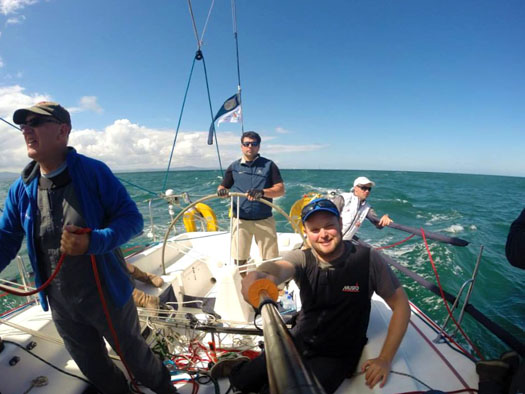
....and nearing the Tuskar Rock on the Saturday evening, they were back in sunshine, and well in contention on the leaderboard.
Within the limits of having a sensible boat which professionals would describe as a comfortable cruiser-racer, they campaign flat out. All meals are built around expeditionary and military Ration Packs, which can be quite expensive to buy in ordinary circumstances, but if you can show they're going to be used for a worthy objective, it's possible to swing a deal, and as Richard's wife Vicky is a physiotherapist who is involved with military reserves, the value of Tanit's campaigns is accepted in the right places. The result is a nourishing supply of reasonably attractive easy-prepare instant food which, as Richard reports still with some wonderment, makes no mess at all in and around the galley, yet keeps the crew on full power.
By the time they got up off the Donegal coast, Tanit was right in there, battling with the defending champion, the Gouy family's Ker 39 Inis Mor, for the overall handicap lead, while up ahead the two biggies, Teng Tools (Enda O'Coineen and Eamonn Crosbie) and the Volvo 70 Monster Project, with David Ryan of Wicklow, kept finding new calms as they tried to shake off the smaller craft.
It was a slow race, but Richie Fearon managed to place Tanit so that she stayed ahead of a calm up in his home waters, and was keeping station on Inis Mor very handily indeed, while the gap with boats astern widened all the time. Or so it seemed. But then the Round Ireland Race pulled one of its regular tricks, and Liam Shanahan and his team on the J/109 Ruth began to shift before they'd even got past Tory Island, and they appeared to carry a useful breeze and a fairtide the whole way from Donegal into the Irish Sea, or at least that's how it looked to the rest of the fleet.
But in closing in over the final stage from Rockabill to Wicklow, navigator Fearon – who was incubating a nasty virus which required antibiotic treatment for a week after the race - convinced Tanit's skipper that they should stay offshore, while Ruth – which seemed to have the race nicely in the bag – followed the Irish habit of hugging the coast. Inis Mor was already finished on Friday morning, but Tanit knew she was beatable by them, and when they came across the line at 1030, it was to move into the CT lead. And going offshore proved to have been their win move.
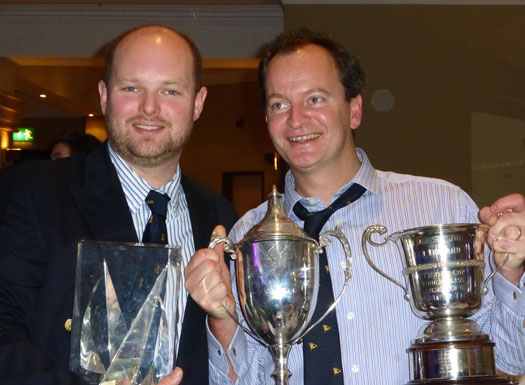
Trophies of the chase – crewman Chris Frize (left) and skipper Richard Harris with some of Tanit's prizes in Wicklow last Saturday night. Photo: W M Nixon
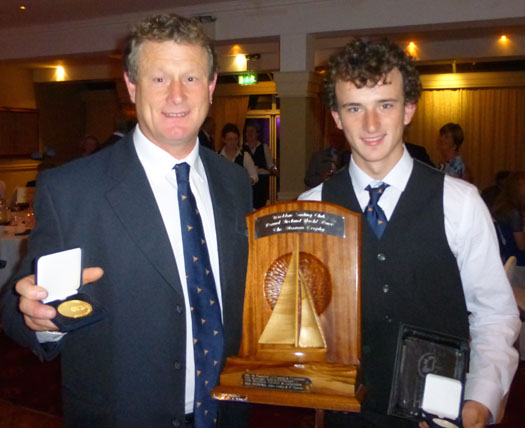
Family effort. Father and son team of Derek and Conor Dillon from Listowel in Kerry (they sail from Foynes) won the two-handed division with their Dehler 34 Big Deal, and placed 8th overall. Photo: W M Nixon
It was a time of screaming frustration for Ruth. She'd been crawling along near Bray Head, barely 15 miles from the finish, as long ago as 0700. She rated only 1.016 to the 1.051 of Tanit. A finish in the middle of lunchtime would do fine. It was so near. It was so far. Finally they got to Wicklow, but Tanit had them beaten by six minutes. Then for the Scottish boat there was just the chance that Ian Hickey's very low-rated veteran Granada 38 Cavatina might do it again. But the wind ran out for her too. Meanwhile Frank Doyle's Endgame came in at mid-afternoon to slot into fourth on CT behind Inis Mor, but Cavatina was fifth, all of five hours corrected astern of Tanit. The Scottish boat was now unbeatable leader.
Tanit's crew for this classic sailing of a true offshore classic was Richard Harris, Richie Fearon, John Highcock, Alan Macleod, Chris Frize, Andy Knowles and Ian Walker. They've a lovely boat of which they're justifiably very fond, but reality has intruded, and now she is indeed for sale. The price is 48K sterling which seems to me very reasonable when you remember that she is remarkably comfortable to sail, that sails and gear have been regularly up-dated, and that we know for certain that the rudder alone is worth 35K.......She's conveniently located for an Irish potential owner, as she's currently ashore in Glasgow. Certainly she has a performance weakness, for as Richard admits, she'll easily get up to 7 knots on a reach, but stubbornly stays there and goes no faster, yet if you harden on to the wind, she'll still be doing 7 knots. But if you go downwind, then whoosh – it's a horizon job on most other boats. Be careful what you wish for, though. With a boat like Tanit in an average fleet, there'll be no excuse for not doing well......
The rest of the trophy placings are here, and on Saturday night they were one lovely compact crowd of people. The family emphasis was inescapable, and it was a particular pleasure to meet the Kerry duo, father and son crew Derek and Conor Dillon from Listowel, who sail out of Foynes in their Dehler 34 Big Deal. In 2015, they plan to take on the two-handed division in the Fastnet, so getting 8th overall and winning the two-handed class in the Round Ireland 2014 was part of a very useful campaign trail.
Finally, as to how to keep the Round Ireland race's distinctive Wicklow flavour while allowing the entry numbers enough room to comfortably expand, it's such a tricky question that it will require a radical solution. A very radical solution. The mistakes of the Vikings must be undone. The Vartry entrance must be dredged, The bridges must all be removed. And the Broad Lough must be tastefully developed to give Wicklow the harbour it deserves, and the Wicklow Round Ireland Race the facilities it needs to cater for a fleet of a hundred and more boats. Simple, really.
ROUND IRELAND RACE TROPHY WINNERS 2014
Line Honours: Denis Doyle Cup - Monster Project (David Ryan, WSC)
IRC Class CK: CK Cup – Monster Project
IRC Class Z: Class Z Cup - Newstalk for Adrenalin (Joe McDonald, NYC)
IRC Class 1: Tuskar Cup – Inis Mor (Laurent Gouy, CBC)
IRC Class 2: Fastnet Cup – Tanit (R Harris, SYC)
IRC Class 3: Skelligs Cup – Ruth (L Shanahan, NYC)
IRC Class 4: Tory Island Cup – Cavatina (I Hickey, RCYC)
Class 5 (Cruiser HF) – Cavatina
Class 6 (pre 1987) Michael Jones Trophy – Cavatina
Class 7 (two-handed) Noonan Trophy – Big Deal (D & C Dillon, FYC)
ICRA Trophy (best Irish boat) - Ruth
Ladies Award: Mizen Head Trophy - Pyxis (Kirsteen Donaldson)
ISORA Award – Ruth
Team Award: Kinsale YC Cup – Endgame (F Doyle), Wild Spirit (P Jackson) & Fujitsu (D B Cattle).
IRC Overall: Norman Barry Trophy – Tanit
Round Ireland Overall: Wicklow Cup - Tanit

Monster boat, monster prizes. Line honours and Class C winner David Ryan of Wicklow, who raced the Volvo 70 Monster Project to success, with Roisin Scanlon, also WSC, who crewed on the Monster during the Round Ireland Race Photo: W M Nixon
Strong Irish Team Contest Laser Master Worlds in Hyeres
#lasermasters – There's a strong contingent of Irish competing in the Laser Masters Worlds taking place from the 4th - 11th October in Hyeres, France this week.
The event has broken records for the number competing which topped out at an eye watering 499.
The logistics and challenges for the event organisers of dealing with a fleet this size both onshore and afloat are daunting but COYCH are managing.
Masters fleets are divided by age brackets. The youngest competitors are 35 in the apprentice fleet. At 45 these "young guns" graduate to Masters and so on as the bands continue up in blocks of 10 years.
The Irish team consists of Worlds stalwart and Great Grand Master Denis O'Sullivan. Chris Arrowsmith from RStGYC is in the Grand Master category. Ed Rice and Nick Walsh from Royal Cork YC along with Colin Galavan from RIYC and Kevin Currier from Ballyholme are in the Masters fleet. The team is rounded out by three Apprentice Masters, Dan O'Connell from RCYC, sailing coach Thomas Chaix and Paul Keane also from RIYC.
The weather has not played ball for the organisers who have been plagued by light airs and blue skies. Nice for the beach, of which there are plenty, but not for sailing. After two days of light racing some fleets have only two results but the Great Grand Masters have yet to finish a race.
After coming second in the Pre Worlds and winning the practice race Thomas Chaix was confident going into the first race but there is no quarter being given in the Apprentice fleet which includes 2 current and a very large percentage of ex Olmypians. The start line and contested mark roundings are not for the faint of heart.
The Masters fleet is around 130 boats so it's further split into Yellow and Red fleets. In the Red fleet Nick Walsh is on the hunt for some good results after a very successful domestic sailing season. Nick's sparring partner from home, Ed Rice is in the Yellow fleet and after a shaky first race put the demons behind him to score a decent result in the 2nd.
Well known RStGYC sailor Chris Arrowsmith had a middle of the road result in the first race but a strange abbreviation "PTSr" appeared beside his and others scores. This seemed to be "Penalty turns, retrospective" i.e. you're not whistled by the jury on the water but they take your number and penalise you after the race. An Australian team sailor was also penalised in this way and took the RC to the protest room where it seems to have been dropped. In the second race Chris scored a very respectable 11th. Onwards and upwards.
The forecast for the next few days is quite mixed. Last night a big rainstorm went through the area and there is a current "Orange" weather alert. Tomorrow the sun is due to come back and the wind is forecast in the 12-18kt range from a stable Easterly direction. This means waves in Hyeres Bay. Sun, Waves and Breeze for a Laser Sailor is better than a lotto win.
There is so much more to say about this event I could go on but I've just heard a gun and the AP is being lowered so I've got to go and get out on the water. For a very well observed flavour of the "internationality" of this event read USA team member Joe Berkeley's piece here
#opti – A consistent showing by Harry Durcan who never fell out of the top three, despite very tricky conditions, at last weekend's Optimist Leinster Championships gave the Royal Cork sailor the title.
Durcan will be Ireland's sole representative at the Argentinian World Championships this October.
Second place at the Royal Irish hosted eveny went to Dara Donnelly of the National Yacht Club and third place to a visiting Maltese sailor. In the senior silver fleet Paddy Cunnane from Dingle Sailing club earned his win with Sarah Fogarty and Kate Darcy second & third in Silver senior fleet.
Optimist class interest now focuses on the European Championships hosted next week at the Royal St. George Yacht Club in Dun Laoghaire.
Senior fleet results available to download below.
Ireland's Oldest Wooden Boats Aren't Getting Any Younger
#woodenboats – On Midsummer's Day, W M Nixon looks back on the already busy and event-filled Irish season of 2014, and reflects on the extraordinary longevity of some boats, their remarkable variety, and the diverse characters who own them.
When I shipped aboard the former Bristol Channel Pilot cutter Madcap to sail the Old Gaffers Division in Howth Yacht Club's Lambay Race on June 7th, it wasn't the first time I'd been out and about on a boat built in the 1870s. But as most of my experiences on John and Sandra Lefroy's 1873-vintage iron-built classic 58ft Victorian steam yacht Phoenix on Lough Derg took place in the 1970s with the most recent jaunt being way back in 1982, sailing on the Madcap was indeed the first time afloat in a boat built 140 years ago.
It takes an effort to get your head around the most basic notion of such an age. You find yourself reflecting on the delights that still awaited the human race at the time, things that were still far into the remote future in the 20th Century. During the 1870s, industrialisation was still gaining traction, but the very idea of warfare on the industrial scale which was to be experienced in the Great War of 1914-18 was beyond most people's imagination, and way beyond anyone's experience. That said, there were more than enough other ways of experiencing an early death, with a range of particularly unpleasant illnesses which have been largely eliminated today.
Yet it was increasing industrialisation which created the circumstances that enabled both boats to be built. The Bristol Channel Pilot cutters evolved rapidly in the latter half of the 19th Century in order to provide pilots for the more numerous and increasingly large ships which were coming into ports such as Cardiff and Bristol. They reached their peak of performance around 1900, by which time they'd achieved a remarkable stage of development, being fast and able, yet comfortable at sea, and capable of being handled by a very small crew after the pilots had been delivered to incoming vessels. When their working days were over as they were replaced by motorised vessels, they proved ideal as seagoing cruising yachts.
There was nothing work-oriented about the pleasure yacht Phoenix when she was built to the designs of Andrew Horn in Waterford in 1873. Or maybe that's being a bit naïve. After all, she is down as having been built by and for the Malcolmsons of Waterford. They were a remarkable clan who brought many industries to Waterford in the 19th Century, and they created the miniature industrial town of Portlaw westward from the city, off the south bank of the Suir Estuary.
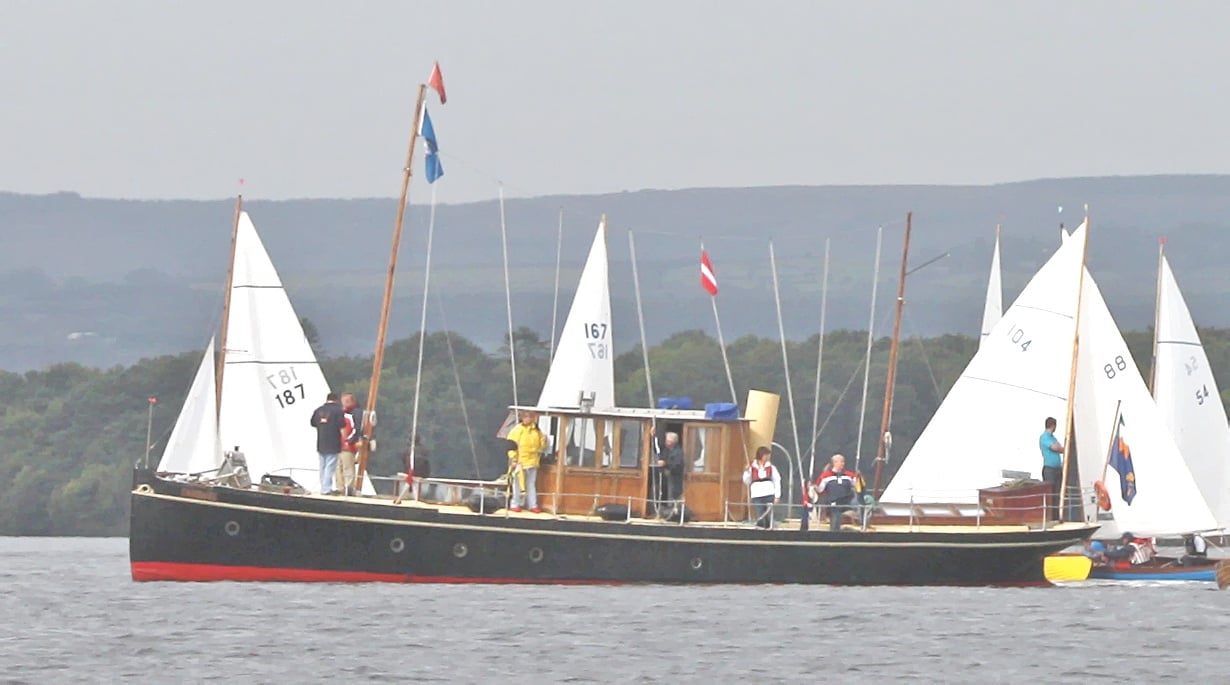
The 58ft Phoenix, iron-built in Waterford in 1873, performing Committee Boat duties at Dromineer for Lough Derg YC. Photo: Gerardine Wisdom
So in building the Phoenix themselves, so to speak, they were creating a subtle advertisement for Waterford expertise, with this new miniature of an ocean liner being constructed in the highly-regarded Lowmoor iron. And she's a powerful statement - this lovely old vessel has lasted much better than many of the Waterford enterprises which outshone her at the time of her building, so much so that if, in Waterford's current recessional woes, they sought something to symbolise what the city is capable of, they would do worse than put some resources the way of the Phoenix for her continuous maintenance.
Five years ago she made a very stylish appearance as the Committee Boat in a classics regatta at Dromineer, and that in turn produced an astonishing photo which included Ian Malcolm's 1898-built Howth 17 Aura. It was the first time a jackyard topsail had been seen on Lough Derg since before the Great War, and all that together with a raft of Shannon One Designs (which date from 1922 onwards) and a fleet of Dublin Bay Water Wags from 1902 onwards meant that the total age of the boat in the photo was pushing towards the 2,000 years mark.

Phoenix and the 1898 Howth 17 Aura (Ian Malcolm) at Dromineer with rafts of Shannon ODs and Water Wags. The combined age of the bots in the photo is well over a thousand years. Photo: Gerardine Wisdom
To be aboard Phoenix is to be transported right back to the 1870s, as she has a beam of only 10.5ft, which on a length of 58.5ft make for one very slim and potent hull. She has long since had her original steam engine replaced with a diesel, and back in 1982 when I was last afloat in her, it was October, and we were the Committee Boat for the annual IYA Helmsmans Championship, raced that year in Shannon One Designs with Dave Cummins of Sutton the winner, crewed by Gordon Maguire.
Being late season, the Phoenix's injectors needed a clean, but as the Race Officers were those perpetual schoolboys Jock Smith and Sam Dix of Malahide, they were delighted by the Phoenix's ability to emit a fine plume of smoke from her funnel at full speed, and after the championship was resolved they tore across the lively waters of Autumnal Lough Derg at full speed while – from another boat - I grabbed some photos which made Phoenix look like a destroyer in action at the Battle of Jutland. One of them subsequently appeared as the cover of Motor Boat & Yachting, and as I seem to have mislaid the colour slides, if anyone has a copy of that particular edition I'd much appreciate a scan of it.
Moving on from the 1873-built Phoenix in 1982 to the 1874-built Madcap in 2014 is quite some saga, but we'll edit it by sticking to events this year revolving around the developing annual Old Gaffer programme in the Irish Sea. Last year Dickie Gomes' 1912-built 36ft John B Kearney yawl Ainmara from Strangford Lough won the inaugural Leinster Trophy race in Dublin Bay which marked the OGA's Golden Jubilee, and she did it despite now being bermuda rigged. But as she was returning to her birthplace in Ringsend for the first time in 90 years, she was treated as an honorary gaffer.
Honour being the theme of things, this meant we were honour-bound to bring her south again to defend the Leinster in 2014, but this was given an added impetus by a plan to link up in Dun Laoghaire with Martin Birch's 1902-built Espanola out of Preston in Lancashire. From 1912 until 1940, the 47ft Espanola was a feature of the Royal Irish YC in Dun Laoghaire, owned by noted sailor Herbert Wright, who in 1929 became the founding Commodore of the Irish Cruising Club when he cruised Espanola with four other yachts to Glengarriff where the ICC was founded on July 13th 1929. The Espanola links, together with the fact that the RIYC is now in partnership with Wicklow Sailing Club in hosting the fleet for the biennial Round Ireland Race, made for a fortuitous combination, as Dickie Gomes of Ainmara was Mr Round Ireland between 1986 and 1993, when he held the open Round Ireland Record and also had been overall winner of the 1988 race.

Espanola as she was in 1929, when Commodore's yacht at the founding of the Irish Cruising Club
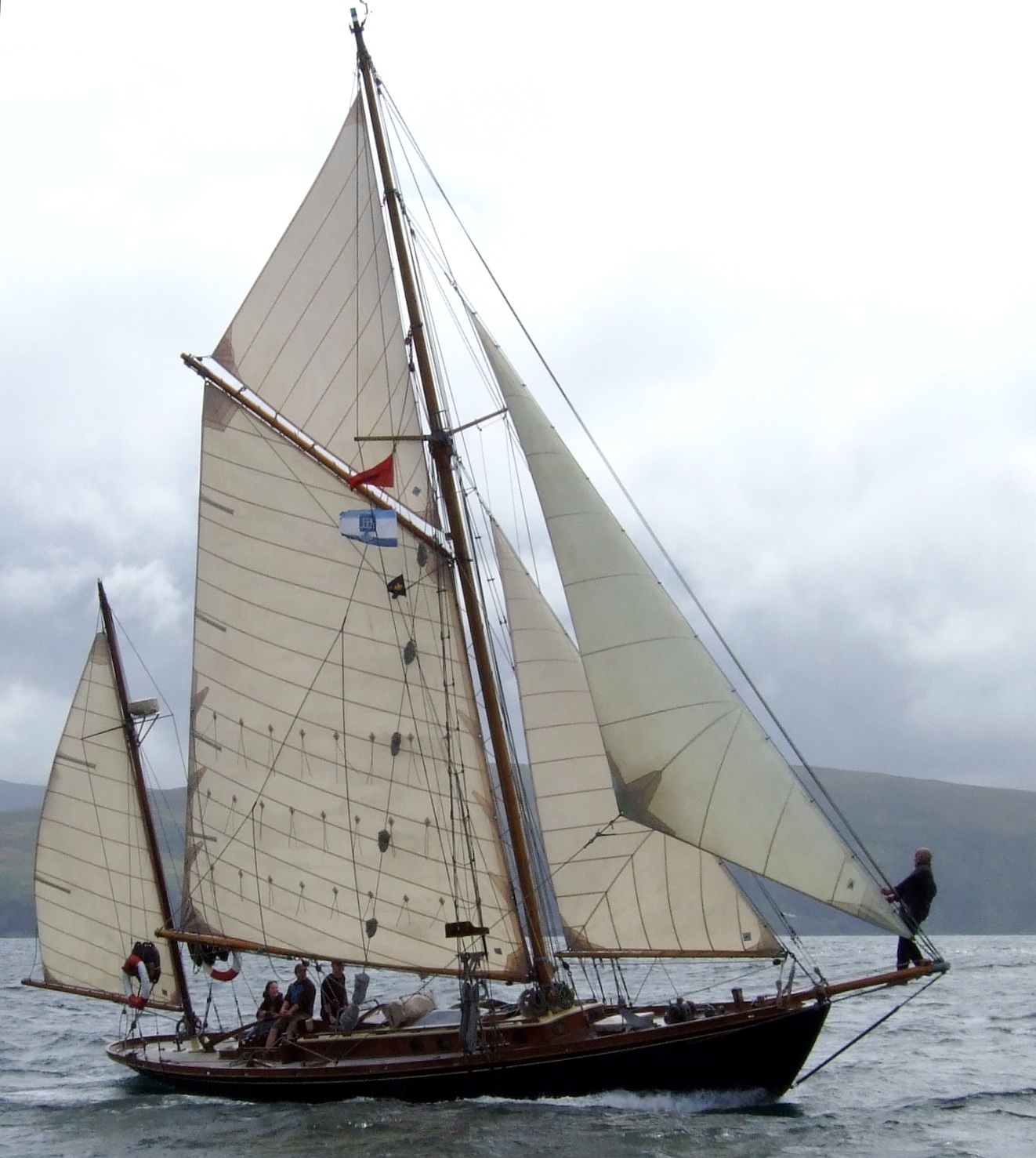
The 1902-built Espanola as she is today
Thus all the stars were in alignment for an historic and convivial meeting of the two old boats at the RIYC on the evening of Friday May 30th, the night before the Leinster Plate race was due to start just round the corner in Scotsmans Bay. But while stars may have been in alignment, ducks failed to get into a row, as Espanola with her exceptional draft of 7ft 6ins failed to get out of Preston over the shallow bar in the one tide which would have suited, on May 16th.
This situation is a useful illustration of the problems the old gaffer people face in keeping the show on the road with limited resources. Martin Birch, having been a lecturer in Lancaster University, had found Preston's little marina an ideal place to keep and maintain Espanola, and the marina in turn regarded the old girl as their pet boat. But Preston is longer a busy commercial port, so the channel has been left to is own devices, and with the huge tides of the Lancashire coast, getting Espanola to sea is quite a challenge as sometimes there's only one day in any month when it can be done.
So there we were, faced with the prospect of Hamlet without the Prince with just ten days to go to the historic gathering at the RIYC. But Jim Horan, affable Commodore of the Royal Irish YC, took it all in his stride and told us to bring Ainmara along anyway, it would be a good excuse for a Friday night party and he was keen to meet the skipper who had made the Round Ireland challenge very much his own 28 years ago.
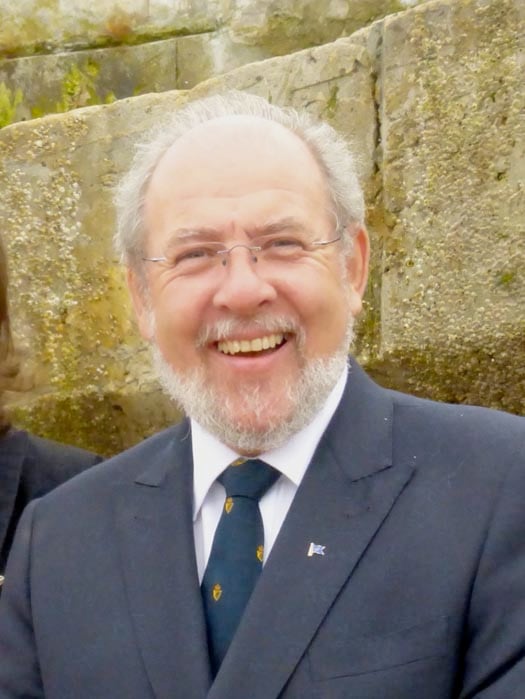
Jim Horan, Commodore of the RIYC, told us to come on and be welcome even though Espanola couldn't make it. Photo: W M Nixon
With the foul weather of mid-May, while Ainmara had got afloat from her winter quarters in a hayshed at the Gomes farm on the Ards peninsula in County Down, further fitting out was difficult in endless rain, and the skipper came down with a massive cold. But then the weather perked up, and he did too, so at lunchtime on Thursday My 29th we headed down Strangford Lough from the Down Cruising Club's former lightship headquarters at Ballydorn to catch the start of the ebb in Strangford Narrows at 1430 hrs.
Progress was good with a light to moderate nor'easter, but Ainmara and her crew (there were four of us – Brian Law, Ed Wheeler and I together with Dickie) have got to the stage where nights at sea are regarded to be the result of bad cruise planning. Yet if we were going to be comfortably in Dun Laoghaire for Friday evening, then only Port Oriel at Clogherhead made sense as an overnight. But Port Oriel, home to some of the best-maintained fishing boats on the coast, can become a very crowded place on a Thursday night.
However, a phone call to the uncrowned king of Clogherhead Aidan Sharkey – whom I'd first met back in the 1980s when our two boats were moored in Seal Hole at Lambay, where he was diving on the nearby 1854 wreck of the Tayleur - ensured there'd be a berth for us, and when we arrived in at sunset there was the man himself to direct us to a corner where we wouldn't inconvenience fishing boats, and moreover had access to a set of proper steps.
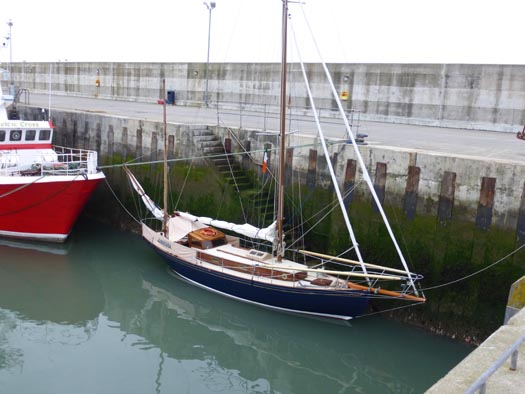
Port Oriel at Clogherhead provided Ainmara wih a handy overnight stop. There was more space available (below) as most of the 30-strong local fleet were away fishing the south coast. Photos: W M Nixon

Aidan's commitment to the maritime life is total. He's of an old Clogherhead fishing family, and he and his late brother Feargal were the backbone of the local beach-launched lifeboat crew. The banter was mighty on board Ainmara, leavened with tales of lifeboat experience which would curl your hair. The laughter through the companionway attracted others board, and soon Sean the razor clam man (all of his catches go straight to China) was in the hatchway with glass in hand, and when we asked where we might get a new deck scrub first thing in the morning as somehow the ship's own one had gone AWOL, Sean said not to worry, he'd throw one on board, and we could just leave it on the big fishing boat beside us as we left next day.
Ashore, I went up to Aidan's house in the village as he'd said he'd something to show me, which was an understatement. He was into the diving much earlier than most, thus when he got to wrecks which today are known to everyone, there were still intact bits of the cargo to be salvaged. Most east coast divers have fragments of chinaware, pottery and other artefacts from the Tayleur, but Sean had so many complete pieces, together with many other items of special antique value from other wrecks mostly in Donegal, that he would be well able to provide complete afternoon tea for the entire choir, all served on 1840s china. But it wasn't tea I got in the Sharkey household, it was Aidan's present of a large bag of fresh crab claws, and a selection of his own-cured salmon – smoked and gravid lax both – which sustained us through the next day's sail.
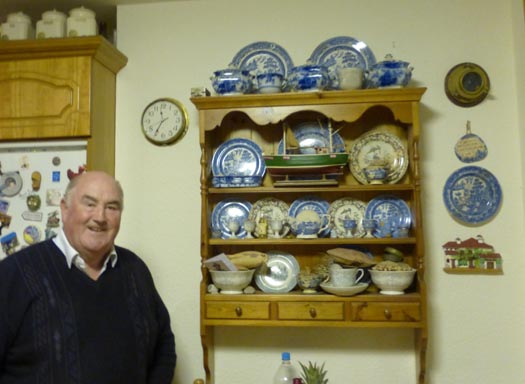
Aidan Sharkey of Clogherhead with some of his remarkable collection of salvaged chinaware. Photo: W M Nixon

The sort of sailing cruising folk dream of. Ainmara shaping up nicely to take the first of the fair tide through the islands at Skerries. Photo: W M Nixon
The morning brought the welcome gift of a decent little sunny east to nor'east breeze, and a lovely beam reach all the way down to Dublin Bay, with the south-going tide caught to perfection at the Skerries islands (and yes, I know it's superfluous to talk of the "Skerries islands", but that's what they're called to differentiate them from the Skerries off Holyhead).
Anyone who was involved in last weekend's ICRA Nationals at the Royal Irish YC will know how this premier club can lay on the welcome with effortless style. In the last weekend of May, Ainmara and her crew had the Royal Irish treatment all to themselves. Sailing Manager Mark McGibney ushered us to the prime berth right at the club where we found ourselves in a miniature maritime museum, with the Quarter Tonner Quest close astern (she was to become the ICRA National Champion a fortnight later), while just across the way was the S&S 36 Sarnia – back in 1966, the Sisk family set Irish sailing alight by bringing this very up-to-the-minute fin-and-skeg fibreglass boat back from builders Cantiere Benello in Italy, where they'd started series production on this ground-breaking Olin Stephens design before the same hull shape became better known as the Swan 36 built by Nautor in Finland.
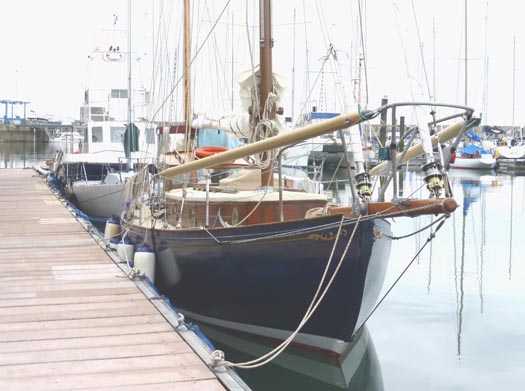
"Maritime museum" at the Royal Irish YC. Ainmara (built Ringsend 1912) with the 1987 Quarter Tonner Quest astern, and the 1966-built S&S 36 Sarnia across the way in her marina berth. Photo: W M Nixon
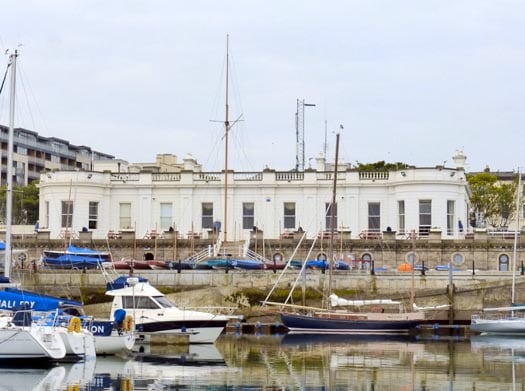
It has to be one of the best berths in the world. Ainmara at the RIYC – it's early morning, and the flags aren't yet hoisted. Photo: W M Nixon
The hospitality flowed seamlessly as the late afternoon graduated into evening and then velvet night. Ainmara is an extraordinarily effective calling card, and the stream of entertaining visitors brought laughter aboard before the Commodore moved us all up to the clubhouse and a fine supper and much chat with Michael O'Leary, one of the most visionary minds in Irish sailing, and his wife Kate and her people with tales of how she and longtime friend Clare Hogan are in the thick of things in the very healthy Water Wag class.
The RIYC took all this in its stride despite the fact that there was a big wedding going in the clubhouse at the same time, but it all went so smoothly that at one stage Ainmara's crew found themselves being invited to join in the wedding celebrations. However, we demurred because we were athletes in training for the Leinster Trophy next day, yet nevertheless certain key players in the wedding got themselves aboard Ainmara at a very late hour.
The plan for Saturday had been changed, but we were right up to speed with this as Denis Aylmer, the RIYC's key man in the OGA, had told us over a convivial pint that the likelihood of light winds had meant that Race Officer John Alvey had moved the scene of the action from Scotsmans Bay to a more compact race area close off the entrance to Dublin Port. It was all grist to our mill, as we could make an early morning departure and head up to Poolbeg Y & BC across a mirror-like bay, lining up the crew to salute the North Bank Lighthouse in the River Liffey, as it's something of a memorial to John B Kearney, whose day job was in the engineering department in Dublin Port and docks. With his original lighthouse, he pioneering a technique of screwing the piles into the seabed. You'd have thought an air of reverence would prevail, but with Ainmara's crew of anarchists, straight faces could only be maintained for about 12 seconds.
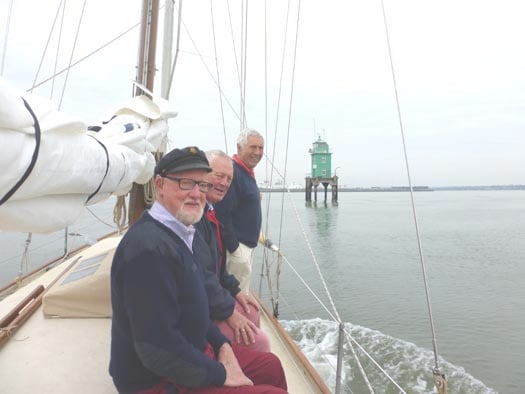
Trying to look appropriately reverential. Ed Wheeler, Brian Law and Dickie Gomes approaching Dublin Port's North Bank Lighthouse on which John B Kearney pioneered the use of screw piles. Photo: W M Nixon

"We're only here for the breakfast". Katy O'Connor's excellent catering in Poolbeg Y & BC is deservedly popular among visiting crews. Photo: W M Nixon
While we wanted to be well on time for the pre-race briefing, the main reason for getting promptly to Poolbeg was to take full advantage of Katy O'Connor's legendary breakfast at the club, and we put away enough calories to keep us going all day. At the briefing, John Alvey told us the committee were concerned that the very varied fleet – everything from Ainmara to the big Naomh Cronan, a superb Clondalkin-built re-creation of a Galway Hooker – included some boats which, in the light airs expected, could be out on the bay until nightfall.
So the plan was for a short race taking in several marks so that it could be finished at the end of any leg. But by the time we got down to Dublin Bay, it was crisp blue with a smart little sea breeze filling in to give sailing conditions which suited Ainmara to perfection, yet some of the heavier gaffers were still lumbering slowly about in what to them was a light wind.
They may have been lumbering about, but several were very determined to make a sharp start right on the committee boat. Anyone accustomed to quick-turning and fast-accelerating modern boats will find a fleet of traditional and classic gaffers a real education. They take time to get moving, they take for ever to stop, you point them a long way out, and their bowsprits – "dock probes" as marina managers call them – seem intent on skewering everyone else.
But while our skipper may pretend to be just an old cruising man these days, his racing blood was up. We set ourselves to sweep into what we hoped would be a gap starting to appear at the committee boat seconds after the start signal. We consoled ourselves with the thought that in extremis, we might just manage to shoot head to wind leaving the committee boat to port, ruining our start perhaps, but preserving the Ainmara intact.
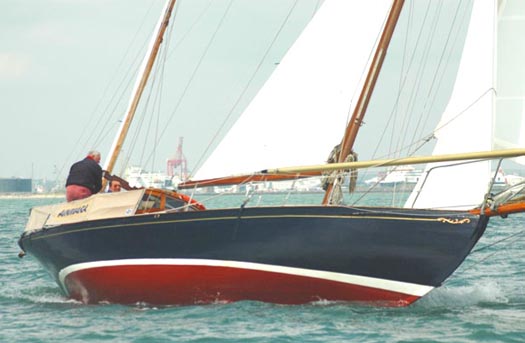
"Go for it, and let's hope there's a gap when we get there..." Ainmara starts to build speed towards her start in the Leinster Trophy Race 2014 . Photo: Gill Mills
So she was set at it, despite attempts to slow her a bit the speed built up, but as quickly as I'm telling this the gap started to appear and she zapped into it and just managed to keep her wind clear on Sean Walsh's remarkably fast Heard 28 Tir na nOg and Denis Aylmer's Mona. Now we had to find the DBSC marks in the right sequence, but Ed was on top of it feeding co-ordinates and giving out courses, we found that with a bit of luck we might just lay the first mark close hauled, and though Tir na nOg – whose waterline length is much the same as Ainmara's – hung in very well, he'd to tack for the mark while we scraped by it, so after that it was up jib tops'l and making hay.
But though we took line honours, we felt certain Tir na nOg would win on corrected time, as a Heard 28 sailed as well as she is can be one very potent performer, and Sean seemd to be still right on our stern at the finish. The results wouldn't be announced until Monday evening, so that Saturday afternoon we wandered back upriver to Poolbeg in sunshine so powerful that an afternoon zizz was your only man, and then we emerged on deck to find that others were arriving in port, with one of the the Welsh visitors, the engine-less Happy Quest from Milford Haven, making a copy-book job of berthing under sail, and then all was alive with the Howth Seventeens arriving in from their home port after a very close-fought passage race which had been narrowly won by Conor Turvey sailing Isobel.

Happy Quest from southwest Wales lives up to her name with a successful berthing under sail only at Poolbeg. Photo: W M Nixon
The Seventeens were there to put on a display race next day (Sunday) in the Liffey as part of the three day Dublin Port Riverfest over the Bank Holiday weekend. Inevitably for those of us who took part in the first one in 2013 when the OGA Golden Jubilee was top of the bill, there wasn't quite the same buzz, but first-timers watching aboard the restaurant ship Cill Airne assured us they found it very exciting indeed, and were especially impressed by the waterborne ballet of the two big harbour tugs Shackleton and Beaufort, while the funfairs and entertainment shows along the quays really did provide something for everything.
Once again the very sight of the Seventeens – which we in Howth tend to take for granted – was fascinating in the city setting. Though the promise of a decent breeze evaporated, Race Officer Harry Gallagher managed to get enough in the way of results to declare Peter Courtney with Oonagh the winner, an appropriate result for an historic class making a show performance, as the Courtneys have been involved with the Howth Seventeens since 1907.
I watched it all from an appropriate setting, aboard the Dutch Tall Ship Morgenster, a handsome 150ft brig which should be required visiting for anyone promoting the idea of a new Tall Ship for Ireland. For the Morgenster – which was re-configured as a sailing ship in 2009 – is run as a commercial venture, and can pay her way through being the right size to be a business proposition, helped by being based in the Netherlands. Thus she has a vast continental catchment area nearby to attract trainees of all ages and abilities who are prepared to pay enough for berths to keep the show efficiently on the road. There are several Dutch-based tall ships run in the same way, and the message is that if you're going to make a go of it commercially, you have to have a large enough and readily-accessed market to make it viable, and you need a boat big enough to carry sufficient trainees relative to the size of the ship – 36 in Morgenster's case – to balance the books.
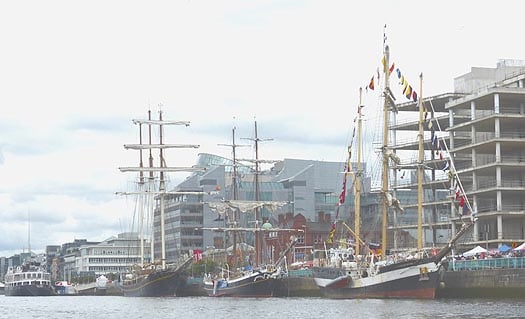
Tall ships in the Liffey, with the commercially-run 150ft sail training big Morgenster at centre. Photo: W M Nixon
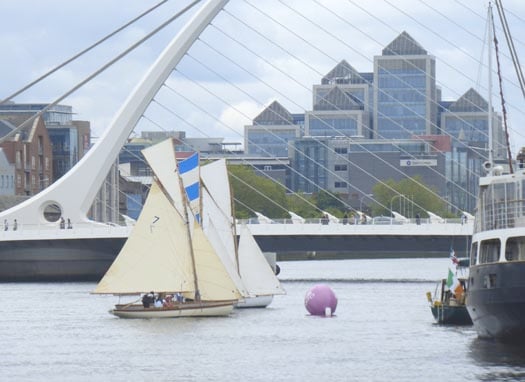
Sails and the city – Howth 17s at the Sam Beckett bridge Photo: W M Nixon
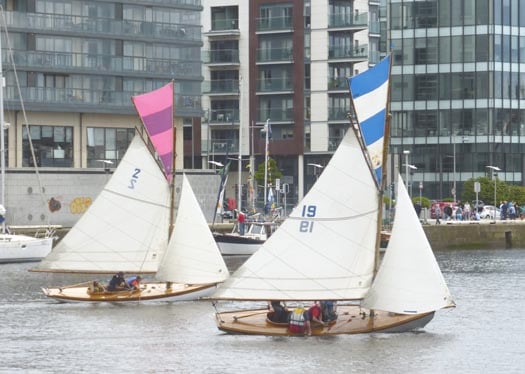
There was just enough wind for the first race for the Howth 17s to show what they could do in the Liffey if the breeze held up. Photo: W M Nixon
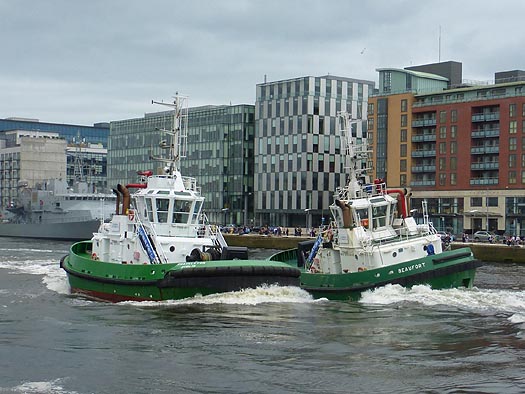
The Dublin Port tugs have awesome power to deploy in their waterborne "ballet" Photo: W M Nixon
But enough of solemnity. We went downriver again for farewells at Poolbeg, and then away across Dublin Bay and round the Baily for a seafood feast in Howth at the new place Crabby Jo's, and a handy overnight stop before using a good westerly next morning to give us a push towards Ardglass where we needs must stop, as the tides into Strangford Lough are a door slammed shut every six hours. But as ever, Ardglass's convenient and friendly little marina provided the perfect decompression chamber, and up in Mulherron's the crack was mighty with the crew of the famous restored Manx longliner Master Frank, just the two of them with skipper Joe Pennington - aka The Rat – being crewed by a psychiatrist who claimed to be strictly on holiday, but we did wonder, as any gathering of Old Gaffers is better than a wardful of nutters.
Ainmara's mini-voyage concluded next day with a text message from Dublin to tell us we'd retained the Leinster Trophy, which surprised us, and then with an idyllic sail in a sunny sou'wester, everything set to the jib tops'l, and all sail carried right through The Narrows, across Strangford Lough and thorough Ringhaddy Sound, and on across a blue sea among green islands past tree covered shores until we handed the sails just off the entrance to Down Cruising Club's isle-girt outer anchorage immediately south of Mahee Island, in a little sheltered area which has somehow acquired the unlovely name of Pongo Bay.

Home again. Ainmara back on her mooring in Strangford Lough, with Brian Law's classic yawl Twilight astern. Photo: W M Nixon
There, Ainmara is securely moored close to Brian Law's own cruising boat, the beautifully restored classic Lion Class yawl Twilight, designed by Arthur Robb. Like Dickie Gomes, Brian does all his own boatwork in a hayshed beside the house. So closely intertwined are their interests that they readily crew for each other, and of course the exchange of information and assistance and re-fit ideas is continuous.
And there's one further fact about these guys which may be of interest to other cruising crews. Aboard Ainmara during the three seasons in which I've cruised on her since she was restored for her Centenary in 1912, there's no kitty to cover expenses. There's an underlying feeling that as the skipper provides the boat, the crew owe him on a permanent basis. Thus if we get into a port and there's a choice between a comfortable marina berth or hanging off a quay wall, the crew will simply slip away and discreetly pay for a marina berth, and then tell the skipper it's a done deal.
Equally, when ashore for a meal, one of the crew will usually sidle off and pay for everyone when no-one else is looking. But if the skipper thinks the day has gone particularly well, you'll sometimes find he's paid for it all himself, As for getting diesel, whoever is carrying the cans will pay for it himself. Then too, when stores are required, it's covered by whoever goes to get them. It all sounds like an accountant's nightmare, yet so far, somehow at the end of the cruise everyone is content with the feeling that it has all balanced out, and as it has worked well for three years and longer, the attitude is that if it ain't broke, then don't try and fix it.
It had been hoped that Ainmara could stay on in the Dublin area for a week to do the Howth YC's Lambay Race in the Old Gaffers division on June 7th, as she won it in 1921. However, there was too much work still to be done to get her completely ready for a busy cruise programme coming rapidly down the line. But as she'll have to be back next year to defend the Leinster Trophy again, who knows but the double event might be done in 2015. As it was, her need for further fitting-out nearer to home was the saving of me, as a mighy temptation arose. The ancient Madcap from the north had stayed on in Dublin Bay, and was doing the Lambay Race with other old gaffers. The word on the waterfront is that Madcap may well be sold to France to be the centrepiece of a maritime museum in La Rochelle. So the Lambay Race might well be the last chance to sail on a 140-year-old boat. A place was secured on board.

The gaffers gather......Tir na nOg, Madcap and Naomh Cronan on misty morning in Howth before the Lambay Race. Photo: W M Nixon
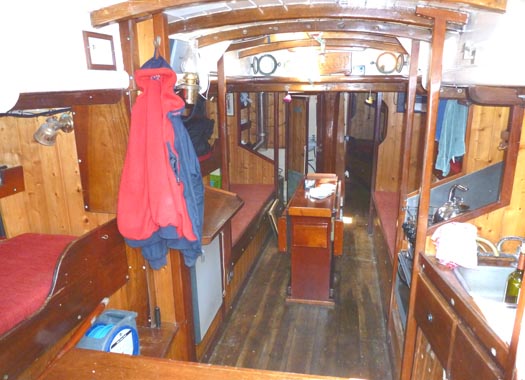
Madcap's sensible accommodation (above and below) reflects the seagoing needs of the pilots for whom she was built140 years ago. Photo: W M Nixon
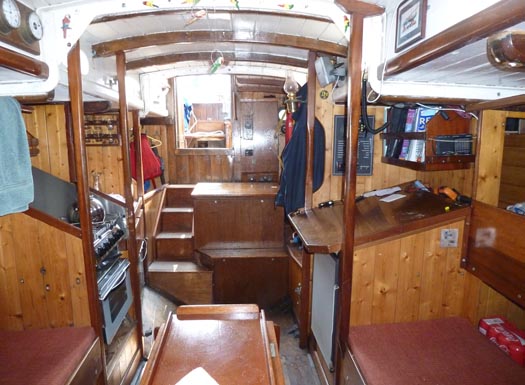
Madcap's owner for more than twenty years now has been Adrian "Stu" Spence, a rugged Belfast barrister who has the essential determination to keep such an ancient boat going. And going places too – he has been to Greenland and several times to Spain and Brittany, and has brought his old cutter through many a problem to log an impressive voyaging record.
If you have a boat of this age, your motto is: When God made time, he made a lot of it. Thus although the Old Gaffer's division was due to start at 1135, five minutes after the Howth Seventeens had set off through Howth Sound to sail the traditional Lambay course leaving Ireland's Eye to starboard and Lambay to port in order to celebrate the centenary of the Lynch family's Howth 17 Echo, it was pushing 1140 by the time we mde our leisurely debut to follow other other gaffers, which had Sean Walsh's keenly-sailed Tir na nOg soon disappearing into the misty asterly, followed by the Galway hooker Naomh Cronan helmed by the great Paddy Murphy of Renvyle, the Cornish crabber Alice (Mark Lynch) and then Madcp in her own good time.
With Northern Ireland Old Gaffers Association President Peter Chambers on the helm, Madcap settled gently into her stride, showing that she needs very little steering – she'll maintain a straight line for miles without the wheel being touched or secured in a any way. It's an oddly soothing characteristic, just the thing to calm a man down after a hectic week in the High Court, and she soon was making her own best speed with a bit of bite now in the breeze, putting Alice astern and keeping Naomh Cronan handily in touch.

"Is it always this foggy off Howth?" Stu Spence and Peter Chambers with he visibility closing in during the Lambay Race. Photo: W M Nixon
The mist became fog, but as ever it was difficult to tell just how thick it was until we suddenly found ourselves surrounded by wraiths in the gloom. It was Class 0 racing towards Lambay, and overtaking us just feet away, giving dramatic close-ups of some of the most likeable boats on the East Coast, with Stephen O'Flaherty's Spirit 54 Soufriere pacing it with Chris Hourican's First 47.7 Pretty Polly and the Tyrrell family from Arklow with their handsome J/122 Aquelina.
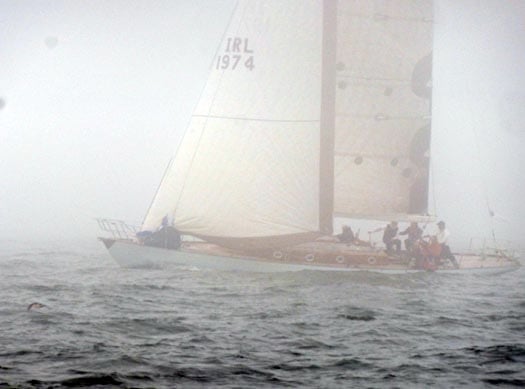
Do not adjust your sets, it really was this foggy for a while. Stephen O'Flaherty's Spirit 54 Soufriere in the fog during the Lambay Race Photo: W M Nixon

Chris Hourican's First 47.7 Pretty Polly in close-up Photo: W M Nixon
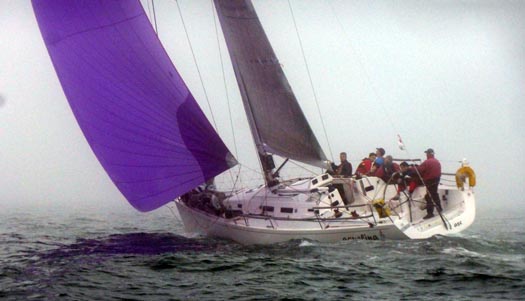
The Tyrrell family's J/122 Aquelina looking her best as she slices through the fog. Photo: W M Nixon
The fog was lifting as we got to the island with boats everywhere – the gaffermen were most impressed. Naomh Croanan had been overtaken, and Peter found us the perfect track along the flukey north side of Lambay, with Madcap effortlessly sliding over the smooth sea on a dead run and apparently consolidating her position.
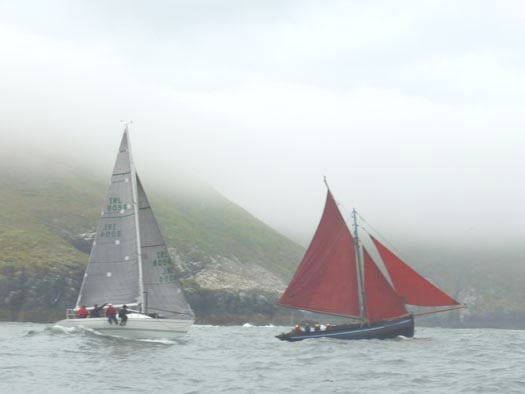
The fog start to lift. Dave Cullen's Half Tonner King One and te Naomh Cronan pproaching the east point of Lambay. Photo: W M Nixon
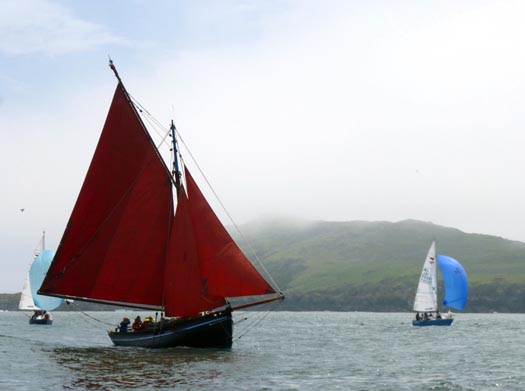
It could be Connemara...., .Naomh Cronan and two Puppeteer 22s off the north coast of Lambay Photo: W M Nixon

The long haul to the finish, the sun is out, and the breeze is beginning to develop enough power to suit Madcap. Photo: W M Nixon
But that was only until we started to head south back to the finish in Howth Sound. The Bermudan boats could lay it, so could the Seventeens, but poor old Madcap was even outpointed by Naomh Cronan, which Paddy Murphy very skilfully kept inside the line of foul tide in Lambay Sound and began to nibble at our lead, while we sagged to lee.
The sun was out, the sailing was lovely, we were surrounded by bustling classes of Puppeteer 22s and Ruffians 23s, and I suggested that a bit more tension in the jib luff, might do the trick, only to be told that as the bowsprit was no more than a liberated telegraph pole, it wasn't really up to the loads which would be put on it by trying to maximise the performance of a 22-ton boat, and nobody wanted splinters flying every which way aboard a boat where the mainboom looked to weigh at least half a ton.
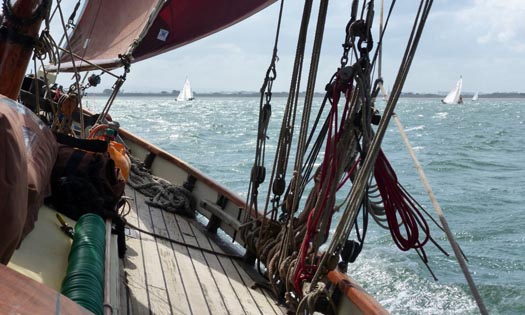
A bite to the breeze, with little boats everywhere – and all of them on starboard. Photo: W M Nixon

The Dun Laoghaire Ruffian 23s made a weekend of it for the Lambay Race, coming over on the Friday night, partying mightily, and then going out to race on Saturday in a rising breeze. Photo: W M Nixon
As it is the loads becme quite something as the breeze freshened sunny and squally down the north flank of the hjill of Howth. By the time we made it across the line, Madcap was going well on smooth water under just mainsail and staysail. But though Naomh Cronan was still ahead and rightly delighted with themselves at getting a good second, it was Tir na nOg which had been in race of her own. Yet as Sean Walsh reported with astonishment, he hadn't been able to get among the slippy little Howth 17s, where John Curley and Marcus Lynch had a good win with Rita, Howth Seventeen No. 1.
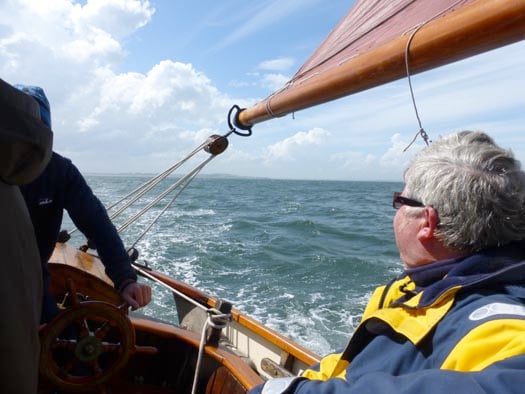
Finally there was enough breeze for Madcap's wake to stretch satisfyingly astern while she could point better with the jib brought in, but Naomh Cronan still finished ahead to take second prize. Photo: W M Nixon

The mighty helmsman of Renvyle. Paddy Murphy (left) steered Naomh Cronan to an excellent performance in the Lambay Race 2014. With him is DBOGA Hon Sec Gerry Murtagh with a trophy he won racing round Lambay in 1986. Photo: W M Nixon
It seemed an Old Gaffers Classic Lambay Race had been inaugurated, and Sean Walsh, international President of the OGA, was most appropriately the first winner. It was something to celebrate, and it duly was, in the sunshine at Howth YC. But in time, I had to take myself away and go for a long walk with the little dog along the beach. For when you've been sailing on a 140-year-old boat, there's a need to ponder the passing years, and this crazy sport of ours in which museum pieces are part of the action.
ICRA Nationals At Royal Irish Yacht Club Hits the Spot
#cruiserracing – The Irish Cruiser-Racing Association had a weekend to celebrate after its three day Teng Tools Nationals at the Royal Irish YC in Dun Laoghaire from Friday June 13th to Sunday June 15th writes W M Nixon.
The mood afterwards was buoyant to the point of exuberance despite losing an entire day's sailing with complete calm throughout what should have been the peak-hitting Saturday. Yet thanks the crisp race management, and the extraordinary machine which is Dublin Bay race administration on top of its form, they zapped through the complete programme in a light to moderate southeast breeze on the Friday, and then took full advantage of gentle but viable onshore breezes on the Sunday to provide a full championship with a very valid set of results.
Lesser souls might well have despaired at the virtually flat wind gradient, but this was a fleet determined to have sport. With 115 boats in six classes, it hugely outshone the British ICRA Nationals taking place in the Solent at the same time, where they mustered just 45 boats in four classes. And even there, it all added to ICRA's lustre, as the winner was Anthony O'Leary's Ker 39 Antix, flagship for ICRA's Commodore's Cup challenge for Ireland next month.
As for the setting for the Irish championship, the hosting Royal Irish Yacht Club was the essence of hospitality, with Commodore James Horan leading his members in making the visitors more than welcome, while the summertime atmosphere each night in the classic clubhouse was an experience to be savoured. And the club itself fielded a remarkably good turnout of members' boats, including the overall winner, Jonathan Skerritt's Quarter Tonner Quest.
Vintage boat aficionados will pay prick up their ears at this news of the supreme champion. Quest is no Spring chicken. She was designed mostly by Marcus Hutchinson in the Rob Humphreys office in Lymington in 1987 for Justin Burke of the National YC, and with Gordon Maguire at the helm, she placed second in the 1987 Quarter Ton Worlds in Cork.

The 27-year-old Quarter Tonner Quest (Jonathan Skerritt) from the host club provided a popular overall winner. Photo: David O’Brien
With Barry Cunningham helming for Jonathan Skerritt during the ICRA Nats, and the crew including Alan Crosbie of Teng Tools, the sweet little Quest saw off the formidable challenge in Class 3 of the Kenefick clan in Tiger, racing in Dublin Bay as Nathan Kirwan Trust.
The overall win for Quest made it a remarkable regatta for classic Rob Humphreys boats. The all-conquering Humphreys Half Tonner Checkmate V of Nigel Biggs (RStGYC) notched yet another win in Class 2, her closest challenger being the Evans brothers from Howth with their near sister-ship The Big Picture, which has been up-graded in Alan Power's workshop in Malahide with a ton of helpful information from the Checkmate squad.

Nigel Biggs’ vintage Humphreys Half Tonner Checkmate XV has had lots of TLC lavished on her, and it shows in her appearance and performance. Photo: David O’Brien
Although the Keneficks may have had their campaign from Crosshaven pipped by Quest, in the big boat classes it was Royal Cork all the way. The J/109s set the pace in Class 1, and after the first day it looked to be going the way of Mark Mansfield helming John Maybury's Joker II. But the joke was on Joker on the Sunday, when Ian Nagle's Jelly Baby made a mighty leap to the top with the owner on the helm and Killian Collins calling the shots.

The Division 0 winning Ker 37 Jump Juice (Denise Phelan, RCYC) still looks bang up to date after several years of racing. Photo: David O’Brien
Class 0 was Jump Juice rampant. This superb Ker 37 still looks state-of-the-art, and with Conor Phelan doing the driving and David Rose calling the shots, the Juice showed an almost uncanny ability to claw her way out of setbacks on the rare occasions when things hadn't gone right, but most of the time she was so out on her own that she emerged at the end of the series ten points clear of runner-up WOW, the Farr 42 of George Sisk, RIYC.
At the other end of the fleet in size, Div 4 was won by the Sonata Asterix (Boushel, Coonihan & Meredith), while the two non-spinnaker Corinthian classes were in their own happy little world, a sort of waterborne croquet, with Paul Tully's Elan 33 White Lotus taking Div 5 while the Club Shamrock Demelza (Windsor Laudan & Steffi Ennis, Howth) swept the board in Div 6 with five wins and four bullets.
ICRA's Barry Rose of Cork, who will be team manager for the Commodore's Cup next month, was more than happy with the regatta: "For sure, most of the boats in the fleet weren't in the first flush of youth. But people are moving on from the worst of the recession, and making the best of what they've got. They're going sailing, they're sailing well, and that's what matters".
Before the Commodore's Cup, he'll be racing Cork Week with his daughter Judy McGrath on her family cruiser-racer Bonanza, a much-loved Impala 28. "We'll be racing with a roller-furling genoa", says Rose, "but you can be absolutely certain we'll give it our very best shot. The sport is going to be better than ever".

Exemple needed more wind to defend her 2013 title, and had to be content with 5th in Division 1. Photo: David O’Brien

Rob O’Connell’s A35 Fools Gold from Dunmore East in a close tussle in Division 1 with John Maybury’s J/109 Joker II (RIYC) helmed by Mark Mansfield (RCYC). Joker II placed 3rd overall, while Fools Gold was 4th in a class of 26. Photo: David O’Brien

Peter Dunlop of Pwllheli SC was racing his J/109 Mojito (9047) in Division 1 against the XP 33 Bon Exemple (X Yachts UK/Colin Byrne RIYC), which was overall winner of the ICRA Nats 2013 in Tralee Bay. In Dublin Bay, they placed 15th and 5th respectively. Photo: David O’Brien

Slack Alice (Shane Statham & Trudi O’Leary) is a veteran GK 34 from Dunmore East, placing 7th out of 23 boats in Division 2. Photo: David O’Brien

Now there’s a neat start. Division 1 gets cleanly away on Sunday, with Bon Exemple (nearest camera) successfully seeking clear air at the pin end. Photo: David O’Brien
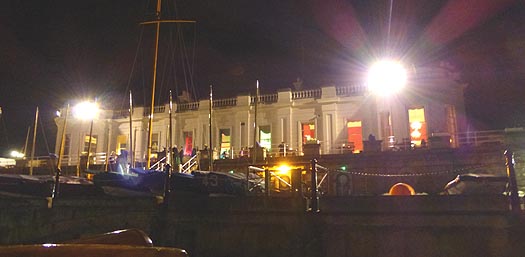
Summer night at the Royal Irish YC. The world’s oldest complete purpose-designed yacht club building provided an ideal setting for the après sailing at the ICRA Nats 2014. Photo: W M Nixon
ICRA NATS 2014 RESULTS (IRC)
Division 0: 1st Jump Juice (Ker 37, Denise Phelan, Royal Cork YC) 8pts; 2nd WOW (Farr 42, George Sisk, Royal Irish YC) 18; 3rd Roxstar (XP 38i, Finlay & Anderson, Clyde Cr C) 19; 4th First Forty Licks (First 40, Jay Colville, East Down YC) 32 (11 raced).
Division 1: 1st Jelly Baby (J/109, Ian Nagle, RCYC) 15; 2nd Rockabill V (Corby 33, Paul O'Higgins, RIYC) 24; 3rd Joker II (J/109, John Maybury, RIYC) 25, 4th Fools Gold (Robert McConnell, Waterford Harbour SC) 35.5, 5th Bon Exemple (XP 33, X-Yachts UK/Colin Byrne, RIYC) 36. (26 raced)
Division 2: 1st Checkmate XV (Humphreys Half Tonner, Nigel Biggs, Royal St George YC) 9; 2nd The Big Picture (Mg30, Richard & Michael Evans, Howth YC) 20; 3rd Fusion (Corby 25, R Colwell & B Cobbe, HYC) 22; 4th Movistar Bleu (Elan 333, Raymond Killops, Killyleagh YC) 28, 5th Dux (X 302, Anthony Gore-Grimes, HYC) 30 (23 raced).
Division 3: 1st (and Overall Winner) Quest (Humphreys Quarter Tonner, Cunningham & Skerritt, RIYC) 7; 2nd Nathan Kirwan Trust (Quarter Tonner, George Kenfick, RCYC) 19; 3rd Hard on Port (J/24, Flor O'Driscoll, RStGYC) 20, 4th Hamilton Bear (J/24, Stefan Hyde, RCYC) 25, 5th White Mischief (Sigma 33, Tim Goodbody, RIYC) 30 (19 raced).
Division 4: 1st Asterix (Hunter Sonata, Boushel, Coonihan & Meredith, DL Marina) 6, 2nd Chousikou (First 28, Declan Ward, DL Marina) 9.
Division 5: (Non-spinnaker) 1st White Lotus (Elan 33, Paul Tully, DL Marina) Div 6 (Non-spinnaker) 1st Demelza (Windsor Laudan & Steffi Ennis, HYC) (19 raced).
Big Boat Classes Won By Royal Cork Yacht Club as ICRA Championship Titles Decided on Dublin Bay
#icra – Royal Cork prowess in big boat racing shone through yesterday in Dun Laoghaire when National Cruiser handicap titles were decided on Dublin Bay in a packed final day for the ICRA championships that brought the best winds of the three day regatta for 115–cruiser–racers. It meant classes zero and one were able to sail four races for a discard after racing was lost in a dead calm on Saturday.
Winning the Class three title with the lowest score of any of the five classes, Jonathan Skerritt's Quest from the host Royal Irish Yacht Club counted three race wins and two second places in a highly consistent performance over the three days at the Teng Tools ICRA championship on Dublin Bay yesterday.
Nigel Biggs on Checkmate V had a similarly low-score with four race wins and though a fifth in yesterday's third race spoiled the straight run, the Class 2 national title went to Biggs of the Royal St. George YC.
A fourth race was added to yesterday's programme that then ran late into the afternoon for the two big-boat classes with the Royal Cork YC taking both national titles.
Denise Phelan's Jump Juice won Class Zero with a comfortable ten-point lead thanks to four race wins and two second places. Ian Nagle's Jelly Baby won the Class One title for the second time since 2012 though with 26 boats in this fleet, the win was less straight-forward despite three race wins.

Denise and Conor Phelan's Jump Juice (Ker 37) from Royal Cork was class zero winner with a ten point margin
Meanwhile there were cheers in Dun Laoghaire last night for and Irish win in Cowes, the British IRC National Championships was won outright by Anthony O'Leary on Antix in a large Class One turn-out of 20 boats. The Royal Cork YC skipper is captain of the ICRA team in this year's Commodores' Cup at the same venue next month.

(Above and below) Maintaining consistent speed in the five to eight knot winds was essential. At times even the keeping the spinnaker flying proved difficult


After a poor weather mark rounding the J109 Powder Monkey goes for the high lane

Competitive starts and finishes. Class one (above) gets away in race four on Sunday lunchtime and (below) a bow to stern class two finish between Tribal (IRL2525) of Galway Bay and the GK Westerly Slack Alice 34 from Dunmore East


That's how it's done. Slick gybing at the Dublin Bay Merrion buoy by class two winner Checkmate V, Nigel Biggs' Humphrey's Half Tonner and (below) heading for another win off Dun Laoghaire harbour


Touch of class. The spirit of James Bond came to town when the secret agent's yacht Soufriere entered in class zero

Entries came from far and near including the west coast. This Shannon estuary based Dehler 34 (above) voyaged from Foynes for the three day event. Derek Dillon's 'Big Deal', sponsored by Union Chandlery, has also enjoyed offshore success on the ISORA circuit during her trip to the east coast. Below Fox in Sox

White sails racing against the Dublin coast off Dalkey

The Royal Irish Yacht Club hosted the 113–boat event with some style
A full ICRA Nationals photo report will appear in Summer Afloat magazine out next week.
Read also: WM Nixon's blog on his Friday sail with the ICRA fleet
Dead Calm at Day Two of ICRA Sailing Champs on Dublin Bay
#cruiserracing – With racing abandoned for the bulk of classes there was frustration for the 113–boat ICRA championship on Dublin Bay today and an earlier start than scheduled for tomorrow's final day of competition.
Classes Zero and One completed their minimum amount of races for a championship after a short round the cans course in less than five knots of breeze but other classes are still looking for more racing tomorrow to complete the series.
In a frustrating day three race management teams afloat, what should have been a full programme was dominated by drifting in dead calm conditions for five hours at the Teng Tools ICRA National Championships today.
Classes Two, Three and Four were expecting three windward-leeward races and though Principal Race Officer Jack Roy managed to get the first group away in a gentle north-east airflow, a windshift to the east followed by a drop to a knot of "Force Nothing" wind saw the race abandoned. The other classes had also only just restarted after a recall in their sequence.
No further racing was possible as the fleet remained at sea until 3pm in the hope of an improvement in conditions. Racing was also abandoned on the Corinthian courses for White Sails entries.
On the 'Round the cans' course, Classes Zero and One managed to complete three legs of their first race before it was shortened by PRO Henry Leonard. The result enabled both classes to complete their minimum quota of three races to qualify for a championship series.
Class Zero was again dominated by Denise Phelan's Jump Juice from the Royal Cork Yacht Club. George Sisk's WOW! from the hosting Royal Irish YC has emerged as the principal challenger while Scottish entry Roxstar holds third overall.
Meanwhile, Class One has had a shake-up after the strong opening day by John Maybury's Joker 2 from the Royal Irish YC on Friday. However, a tenth today along with a race win for Paul O'Higgins Rockabill V leaves the two boats tied on points.
With a marginally better forecast for tomorrow with a possiblilty of clearer skies that may allow a sea breeze to develop, organisers announced that racing will begin one hour earlier than planned. Warning signals for all three courses will be at 0955 IST.
Full results are available here
ICRA Fleet Leaders Emerge After Light Air Start to National Championships on Dublin Bay
#cruiser-racing– It may have been light and shifty but Nigel Bigg's Half-tonner Checkmate V from the Royal St. George YC gave a show of strength when he took two race wins in Division Two of the ICRA National Championships that began today on Dublin Bay.
Despite light winds of between eight and three knots at times, both planned races in all seven classes at the Teng Tools sponsored ICRA Championships were sailed where a 113-strong fleet is competing in the biggest Irish sailing event of the year.
Inspite of the early win Bigg's has competition in class two with a close challenge from The Big Picture, Richard and Michael Evans' equally consistent Howth performer with two second places.
In other classes after taking the first race with apparent ease, George and Neil Kenefick's Royal Cork YC quarter-tonner Nathan Kirwan Trust missed a crucial course amendment shortly before race two which cost an expensive sixth place and third overall for the day. The slip left the way clear for Jonathan Skerritt's Quest from the Royal Irish YC to take the overnight lead with a 2-1 result for the day.
The strongest overnight lead lead after day one belongs to John Maybury's Joker 2, a J109 from the RIYC that includes veteran Olympian Mark Mansfield on board. A 1-2 performance for the day plus mixed fortunes for the remainder of this 26-strong fleet gives Joker 2 a seven-point lead going into tomorrow's three-race programme.
Consistent form for Denise Phelan's Jump Juice from the RCYC with two second places for the opening day was enough to secure the overnight lead in Class Zero where eleven boats have entered. Scottish entry Roxstar appeared to have the upper hand in the series with a win in the opening race but slipped in the trickier conditions of the afternoon and lies on level points with George Sisk's WOW! from the RIYC: both had a win and a fifth place yesterday in what could prove to be a three-way contest for the class.
In the non-spinnaker classes, Paul Tully's Elan 333 from Dun Laoghaire Marina leads Class 5 with two wins while Windsor Laudan and Steffi Ennis from Howth YC were in similar form on the venerable Club Shamrock Demelza to lead Class 6.
If today's results are a measure, consistency in light airs performance is paramount as the forecast is for more of the same til Sunday.
Results here.






























